c++面向对象程序设计课后答案 谭浩强
- 格式:doc
- 大小:107.00 KB
- 文档页数:20
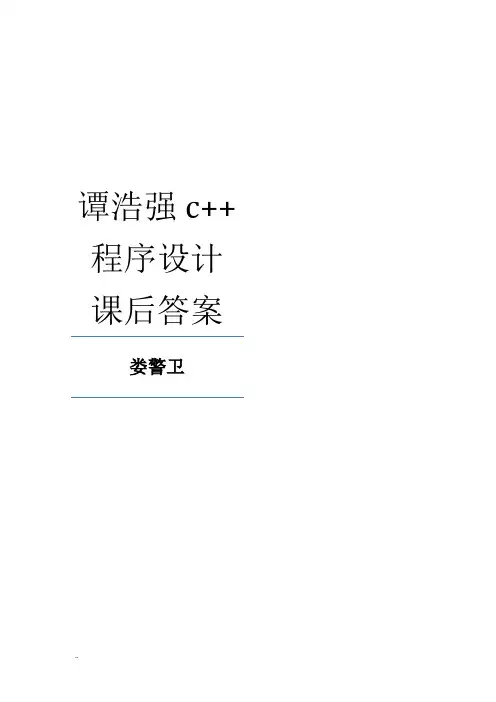
谭浩强c++程序设计课后答案娄警卫第一章1.5题#include <iostream> using namespace std; int main(){cout<<"This"<<"is"; cout<<"a"<<"C++"; cout<<"program."; return 0;1.6题#include <iostream> using namespace std; int main(){int a,b,c;a=10;b=23;c=a+b;cout<<"a+b="; cout<<c;cout<<endl;return 0;}1.7七题#include <iostream> using namespace std; int main(){int a,b,c;int f(int x,int y,int z); cin>>a>>b>>c;c=f(a,b,c);cout<<c<<endl; return 0;}int f(int x,int y,int z) {int m;if (x<y) m=x;else m=y;if (z<m) m=z;return(m);}1.8题#include <iostream>using namespace std;int main(){int a,b,c;cin>>a>>b;c=a+b;cout<<"a+b="<<a+b<<endl; return 0;}1.9题#include <iostream>using namespace std;int main(){int a,b,c;int add(int x,int y); cin>>a>>b;c=add(a,b);cout<<"a+b="<<c<<endl; return 0;}int add(int x,int y){int z;z=x+y;return(z);}第二章2.3题#include <iostream>using namespace std;int main(){char c1='a',c2='b',c3='c',c4='\101',c5='\116'; cout<<c1<<c2<<c3<<'\n';cout<<"\t\b"<<c4<<'\t'<<c5<<'\n';return 0;}2.4题#include <iostream>using namespace std;int main(){char c1='C',c2='+',c3='+';cout<<"I say: \""<<c1<<c2<<c3<<'\"';cout<<"\t\t"<<"He says: \"C++ is very interesting!\""<< '\n';return 0;}2.7题#include <iostream>using namespace std;int main(){int i,j,m,n;i=8;j=10;m=++i+j++;n=(++i)+(++j)+m;cout<<i<<'\t'<<j<<'\t'<<m<<'\t'<<n<<endl; return 0;}2.8题#include <iostream>using namespace std;int main(){char c1='C', c2='h', c3='i', c4='n', c5='a';c1+=4;c2+=4;c3+=4;c4+=4;c5+=4;cout<<"password is:"<<c1<<c2<<c3<<c4<<c5<<endl;return 0;}第三章3.2题#include <iostream>#include <iomanip>using namespace std;int main ( ){float h,r,l,s,sq,vq,vz;const float pi=3.1415926;cout<<"please enter r,h:";cin>>r>>h;l=2*pi*r;s=r*r*pi;sq=4*pi*r*r;vq=3.0/4.0*pi*r*r*r;vz=pi*r*r*h;cout<<setiosflags(ios::fixed)<<setiosflags(ios:: right)<<setprecision(2);cout<<"l= "<<setw(10)<<l<<endl;cout<<"s= "<<setw(10)<<s<<endl;cout<<"sq="<<setw(10)<<sq<<endl;cout<<"vq="<<setw(10)<<vq<<endl;cout<<"vz="<<setw(10)<<vz<<endl;return 0;}3.3题#include <iostream>using namespace std;int main (){float c,f;cout<<"请输入一个华氏温度:";cin>>f;c=(5.0/9.0)*(f-32); //注意5和9要用实型表示,否则5/9值为0cout<<"摄氏温度为:"<<c<<endl;return 0;};3.4题#include <iostream>using namespace std;int main ( ){char c1,c2;cout<<"请输入两个字符c1,c2:";c1=getchar(); //将输入的第一个字符赋给c1c2=getchar(); //将输入的第二个字符赋给c2cout<<"用putchar函数输出结果为:"; putchar(c1);putchar(c2);cout<<endl;cout<<"用cout语句输出结果为:";cout<<c1<<c2<<endl;return 0;}3.4题另一解#include <iostream>using namespace std;int main ( ){char c1,c2;cout<<"请输入两个字符c1,c2:";c1=getchar(); //将输入的第一个字符赋给c1c2=getchar(); //将输入的第二个字符赋给c2cout<<"用putchar函数输出结果为:"; putchar(c1);putchar(44);putchar(c2);cout<<endl;cout<<"用cout语句输出结果为:";cout<<c1<<","<<c2<<endl;return 0;}3.5题#include <iostream>using namespace std;int main ( ){char c1,c2;int i1,i2; //定义为整型cout<<"请输入两个整数i1,i2:";cin>>i1>>i2;c1=i1;c2=i2;cout<<"按字符输出结果为:"<<c1<<" , "<<c2<<endl;return 0;}3.8题#include <iostream>using namespace std;int main ( ){ int a=3,b=4,c=5,x,y;cout<<(a+b>c && b==c)<<endl;cout<<(a||b+c && b-c)<<endl;cout<<(!(a>b) && !c||1)<<endl;cout<<(!(x=a) && (y=b) && 0)<<endl;cout<<(!(a+b)+c-1 && b+c/2)<<endl; return 0;}3.9题include <iostream>using namespace std;int main ( ){int a,b,c;cout<<"please enter three integer numbers:";cin>>a>>b>>c;if(a<b)if(b<c)cout<<"max="<<c;elsecout<<"max="<<b;else if (a<c)cout<<"max="<<c;elsecout<<"max="<<a;cout<<endl;return 0;}3.9题另一解#include <iostream>using namespace std;int main ( ){int a,b,c,temp,max ;cout<<"please enter three integer numbers:";cin>>a>>b>>c;temp=(a>b)?a:b; /* 将a和b中的大者存入temp中*/max=(temp>c)?temp:c; /* 将a和b中的大者与c比较,最大者存入max*/cout<<"max="<<max<<endl;return 0;}3.10题#include <iostream>using namespace std;int main ( ){int x,y;cout<<"enter x:";cin>>x;if (x<1){y=x;cout<<"x="<<x<<", y=x="<<y;}else if (x<10) // 1≤x<10{y=2*x-1;cout<<"x="<<x<<", y=2*x-1="<<y;}else// x≥10{y=3*x-11;cout<<"x="<<x<<",y=3*x-11="<<y;}cout<<endl;return 0;}3.11题#include <iostream>using namespace std; int main (){float score;char grade;cout<<"please enter score of student:"; cin>>score;while (score>100||score<0){cout<<"data error,enter data again.";cin>>score;}switch(int(score/10)){case 10:case 9: grade='A';break;case 8: grade='B';break;case 7: grade='C';break;case 6: grade='D';break;default:grade='E';}cout<<"score is "<<score<<", grade is "<<grade<<endl;return 0;}3.12题#include <iostream>using namespace std;int main (){long int num;intindiv,ten,hundred,thousand,ten_thousand,pla ce;/*分别代表个位,十位,百位,千位,万位和位数*/cout<<"enter an integer(0~99999):"; cin>>num;if (num>9999)place=5;else if (num>999)place=4;else if (num>99)place=3;else if (num>9)place=2;else place=1;cout<<"place="<<place<<endl;//计算各位数字ten_thousand=num/10000;thousand=(int)(num-ten_thousand*10000)/1 000;hundred=(int)(num-ten_thousand*10000-tho usand*1000)/100;ten=(int)(num-ten_thousand*10000-thousan d*1000-hundred*100)/10;indiv=(int)(num-ten_thousand*10000-thousa nd*1000-hundred*100-ten*10);cout<<"original order:";switch(place){case5:cout<<ten_thousand<<","<<thousand<<","< <hundred<<","<<ten<<","<<indiv<<endl;cout<<"reverse order:";cout<<indiv<<ten<<hundred<<thousand<<ten _thousand<<endl;break;case4:cout<<thousand<<","<<hundred<<","<<ten <<","<<indiv<<endl;cout<<"reverse order:";cout<<indiv<<ten<<hundred<<thousand<<en dl;break;case3:cout<<hundred<<","<<ten<<","<<indiv<<en dl;cout<<"reverse order:";cout<<indiv<<ten<<hundred<<endl;break;case 2:cout<<ten<<","<<indiv<<endl;cout<<"reverse order:";cout<<indiv<<ten<<endl;break;case 1:cout<<indiv<<endl;cout<<"reverse order:";cout<<indiv<<endl;break;}return 0;}3.13题#include <iostream>using namespace std;int main (){ long i; //i为利润floatbonus,bon1,bon2,bon4,bon6,bon10;bon1=100000*0.1; //利润为10万元时的奖金bon2=bon1+100000*0.075; //利润为20万元时的奖金bon4=bon2+100000*0.05; //利润为40万元时的奖金bon6=bon4+100000*0.03; //利润为60万元时的奖金bon10=bon6+400000*0.015; //利润为100万元时的奖金cout<<"enter i:";cin>>i;if (i<=100000)bonus=i*0.1;//利润在10万元以内按10%提成奖金else if (i<=200000)bonus=bon1+(i-100000)*0.075; //利润在10万元至20万时的奖金else if (i<=400000)bonus=bon2+(i-200000)*0.05; //利润在20万元至40万时的奖金else if (i<=600000)bonus=bon4+(i-400000)*0.03; //利润在40万元至60万时的奖金else if (i<=1000000)bonus=bon6+(i-600000)*0.015; //利润在60万元至100万时的奖金elsebonus=bon10+(i-1000000)*0.01; //利润在100万元以上时的奖金cout<<"bonus="<<bonus<<endl;return 0;}3.13题另一解#include <iostream>using namespace std;int main (){long i;float bonus,bon1,bon2,bon4,bon6,bon10; int c;bon1=100000*0.1;bon2=bon1+100000*0.075;bon4=bon2+200000*0.05;bon6=bon4+200000*0.03;bon10=bon6+400000*0.015;cout<<"enter i:";cin>>i;c=i/100000;if (c>10) c=10;switch(c){case 0: bonus=i*0.1; break;case 1: bonus=bon1+(i-100000)*0.075; break;case 2:case3:bonus=bon2+(i-200000)*0.05;break;case 4:case5:bonus=bon4+(i-400000)*0.03;break;case 6:case 7:case 8:case 9: bonus=bon6+(i-600000)*0.015; break;case 10: bonus=bon10+(i-1000000)*0.01;}cout<<"bonus="<<bonus<<endl;return 0;}3.14题#include <iostream>using namespace std;int main (){int t,a,b,c,d;cout<<"enter four numbers:";cin>>a>>b>>c>>d;cout<<"a="<<a<<", b="<<b<<", c="<<c<<",d="<<d<<endl;if (a>b){t=a;a=b;b=t;}if (a>c){t=a; a=c; c=t;}if (a>d){t=a; a=d; d=t;}if (b>c){t=b; b=c; c=t;}if (b>d){t=b; b=d; d=t;}if (c>d){t=c; c=d; d=t;}cout<<"the sorted sequence:"<<endl;cout<<a<<", "<<b<<", "<<c<<", "<<d<<endl; return 0;}3.15题#include <iostream>using namespace std;int main (){int p,r,n,m,temp;cout<<"please enter two positive integer numbers n,m:";cin>>n>>m;if (n<m){temp=n;n=m;m=temp; //把大数放在n中, 小数放在m中}p=n*m; //先将n和m的乘积保存在p中, 以便求最小公倍数时用while (m!=0) //求n和m的最大公约数{r=n%m;n=m;m=r;}cout<<"HCF="<<n<<endl;cout<<"LCD="<<p/n<<endl; // p是原来两个整数的乘积return 0;}3.16题#include <iostream>using namespace std;int main (){char c;int letters=0,space=0,digit=0,other=0;cout<<"enter one line::"<<endl;while((c=getchar())!='\n'){if (c>='a' && c<='z'||c>='A' && c<='Z')letters++;else if (c==' ')space++;else if (c>='0' && c<='9')digit++;elseother++;}cout<<"letter:"<<letters<<", space:"<<space<<", digit:"<<digit<<", other:"<<other<<endl;return 0;}3.17题#include <iostream>using namespace std;int main (){int a,n,i=1,sn=0,tn=0;cout<<"a,n=:";cin>>a>>n;while (i<=n){tn=tn+a; //赋值后的tn为i个a 组成数的值sn=sn+tn; //赋值后的sn为多项式前i项之和a=a*10;++i;}cout<<"a+aa+aaa+...="<<sn<<endl;return 0;}3.18题#include <iostream>using namespace std;int main (){float s=0,t=1;int n;for (n=1;n<=20;n++){t=t*n; // 求n!s=s+t; // 将各项累加}cout<<"1!+2!+...+20!="<<s<<endl;return 0;}3.19题#include <iostream>using namespace std;int main (){int i,j,k,n;cout<<"narcissus numbers are:"<<endl;for (n=100;n<1000;n++){i=n/100;j=n/10-i*10;k=n%10;if (n == i*i*i + j*j*j + k*k*k)cout<<n<<" ";}cout<<endl;return 0;}3.20题#include <iostream>using namespace std;int main(){const int m=1000; // 定义寻找范围int k1,k2,k3,k4,k5,k6,k7,k8,k9,k10;int i,a,n,s;for (a=2;a<=m;a++) // a是2~1000之间的整数,检查它是否为完数{n=0; // n用来累计a的因子的个数s=a; // s用来存放尚未求出的因子之和,开始时等于afor (i=1;i<a;i++) // 检查i是否为a 的因子if (a%i==0) // 如果i是a的因子{n++; // n加1,表示新找到一个因子s=s-i; // s减去已找到的因子,s的新值是尚未求出的因子之和switch(n) // 将找到的因子赋给k1,...,k10{case 1:k1=i; break; // 找出的笫1个因子赋给k1case 2:k2=i; break; // 找出的笫2个因子赋给k2case 3:k3=i; break; // 找出的笫3个因子赋给k3case 4:k4=i; break; // 找出的笫4个因子赋给k4case 5:k5=i; break; // 找出的笫5个因子赋给k5case 6:k6=i; break; // 找出的笫6个因子赋给k6case 7:k7=i; break; // 找出的笫7个因子赋给k7case 8:k8=i; break; // 找出的笫8个因子赋给k8case 9:k9=i; break; // 找出的笫9个因子赋给k9case 10:k10=i; break; // 找出的笫10个因子赋给k10}}if (s==0) // s=0表示全部因子都已找到了{cout<<a<<" is a 完数"<<endl;cout<<"its factors are:";if (n>1) cout<<k1<<","<<k2; // n>1表示a至少有2个因子if (n>2) cout<<","<<k3; // n>2表示至少有3个因子,故应再输出一个因子if (n>3) cout<<","<<k4; // n>3表示至少有4个因子,故应再输出一个因子if (n>4) cout<<","<<k5; // 以下类似if (n>5) cout<<","<<k6;if (n>6) cout<<","<<k7;if (n>7) cout<<","<<k8;if (n>8) cout<<","<<k9;if (n>9) cout<<","<<k10;cout<<endl<<endl;}}return 0;}3.20题另一解#include <iostream>using namespace std;int main(){int m,s,i;for (m=2;m<1000;m++){s=0;for (i=1;i<m;i++)if ((m%i)==0) s=s+i;if(s==m){cout<<m<<" is a完数"<<endl;cout<<"its factors are:";for (i=1;i<m;i++)if (m%i==0) cout<<i<<" ";cout<<endl;}}return 0;}3.20题另一解#include <iostream>using namespace std;int main(){int k[11];int i,a,n,s;for (a=2;a<=1000;a++){n=0;s=a;for (i=1;i<a;i++)if ((a%i)==0){n++;s=s-i;k[n]=i; // 将找到的因子赋给k[1]┅k[10]}if (s==0){cout<<a<<" is a 完数"<<endl;cout<<"its factors are:";for (i=1;i<n;i++)cout<<k[i]<<" ";cout<<k[n]<<endl;}}return 0;}3.21题#include <iostream>using namespace std;int main(){int i,t,n=20;double a=2,b=1,s=0;for (i=1;i<=n;i++){s=s+a/b;t=a;a=a+b; // 将前一项分子与分母之和作为下一项的分子b=t; // 将前一项的分子作为下一项的分母}cout<<"sum="<<s<<endl;return 0;} 3.22题#include <iostream>using namespace std;int main(){int day,x1,x2;day=9;x2=1;while(day>0){x1=(x2+1)*2; // 第1天的桃子数是第2天桃子数加1后的2倍x2=x1;day--;}cout<<"total="<<x1<<endl;return 0;}3.23题#include <iostream>#include <cmath>using namespace std;int main(){float a,x0,x1;cout<<"enter a positive number:"; cin>>a; // 输入a的值x0=a/2;x1=(x0+a/x0)/2;do{x0=x1;x1=(x0+a/x0)/2;}while(fabs(x0-x1)>=1e-5);cout<<"The square root of "<<a<<" is "<<x1<<endl;return 0;}3.24题#include <iostream>using namespace std;int main(){int i,k;for (i=0;i<=3;i++) // 输出上面4行*号{for (k=0;k<=2*i;k++)cout<<"*"; // 输出*号cout<<endl; //输出完一行*号后换行}for (i=0;i<=2;i++) // 输出下面3行*号{for (k=0;k<=4-2*i;k++)cout<<"*"; // 输出*号cout<<endl; // 输出完一行*号后换行}return 0;}3.25题#include <iostream>using namespace std;int main(){char i,j,k; /* i是a的对手;j是b的对手;k是c的对手*/for (i='X';i<='Z';i++)for (j='X';j<='Z';j++)if (i!=j)for (k='X';k<='Z';k++)if (i!=k && j!=k)if (i!='X' && k!='X' && k!='Z')cout<<"A--"<<i<<"B--"<<j<<" C--"<<k<<endl;return 0;}第四章4.1题#include <iostream>using namespace std;int main(){int hcf(int,int);int lcd(int,int,int);int u,v,h,l;cin>>u>>v;h=hcf(u,v);cout<<"H.C.F="<<h<<endl;l=lcd(u,v,h);cout<<"L.C.D="<<l<<endl;return 0;}int hcf(int u,int v){int t,r;if (v>u){t=u;u=v;v=t;}while ((r=u%v)!=0){u=v;v=r;}return(v);}int lcd(int u,int v,int h){return(u*v/h);}4.2题#include <iostream>#include <math.h>using namespace std;float x1,x2,disc,p,q;int main(){void greater_than_zero(float,float); void equal_to_zero(float,float);void smaller_than_zero(float,float); float a,b,c;cout<<"input a,b,c:";cin>>a>>b>>c;disc=b*b-4*a*c;cout<<"root:"<<endl;if (disc>0){greater_than_zero(a,b);cout<<"x1="<<x1<<",x2="<<x2<<endl; }else if (disc==0){equal_to_zero(a,b);cout<<"x1="<<x1<<",x2="<<x2<<endl;}else{smaller_than_zero(a,b);cout<<"x1="<<p<<"+"<<q<<"i"<<endl;cout<<"x2="<<p<<"-"<<q<<"i"<<endl;}return 0;}void greater_than_zero(float a,float b) /* 定义一个函数,用来求disc>0时方程的根*/{x1=(-b+sqrt(disc))/(2*a);x2=(-b-sqrt(disc))/(2*a);}void equal_to_zero(float a,float b) /* 定义一个函数,用来求disc=0时方程的根*/{x1=x2=(-b)/(2*a);}void smaller_than_zero(float a,float b) /* 定义一个函数,用来求disc<0时方程的根*/{p=-b/(2*a);q=sqrt(-disc)/(2*a);}4.3题#include <iostream>using namespace std;int main(){int prime(int); /* 函数原型声明*/int n;cout<<"input an integer:";cin>>n;if (prime(n))cout<<n<<" is a prime."<<endl;elsecout<<n<<" is not a prime."<<endl;return 0;}int prime(int n){int flag=1,i;for (i=2;i<n/2 && flag==1;i++)if (n%i==0)flag=0;return(flag);}4.4题#include <iostream>using namespace std;int main(){int fac(int);int a,b,c,sum=0;cout<<"enter a,b,c:";cin>>a>>b>>c;sum=sum+fac(a)+fac(b)+fac(c);cout<<a<<"!+"<<b<<"!+"<<c<<"!="<<sum<<e ndl;return 0;}int fac(int n){int f=1;for (int i=1;i<=n;i++)f=f*i;return f;}4.5题#include <iostream>#include <cmath>using namespace std;int main(){double e(double);double x,sinh;cout<<"enter x:";cin>>x;sinh=(e(x)+e(-x))/2;cout<<"sinh("<<x<<")="<<sinh<<endl;return 0;}double e(double x){return exp(x);}4.6题#include <iostream>#include <cmath>using namespace std;int main(){doublesolut(double ,double ,double ,double ); double a,b,c,d;cout<<"input a,b,c,d:";cin>>a>>b>>c>>d;cout<<"x="<<solut(a,b,c,d)<<endl;return 0;}double solut(double a,double b,double c,double d){double x=1,x0,f,f1;do{x0=x;f=((a*x0+b)*x0+c)*x0+d;f1=(3*a*x0+2*b)*x0+c;x=x0-f/f1;}while(fabs(x-x0)>=1e-5);return(x);}4.7题#include <iostream>#include <cmath>using namespace std;int main(){void godbaha(int);int n;cout<<"input n:";cin>>n;godbaha(n);return 0;}void godbaha(int n){int prime(int);int a,b;for(a=3;a<=n/2;a=a+2){if(prime(a)){b=n-a;if (prime(b))cout<<n<<"="<<a<<"+"<<b<<endl;}}}int prime(int m){int i,k=sqrt(m);for(i=2;i<=k;i++)if(m%i==0) break;if (i>k) return 1;else return 0;}4.8题#include <iostream>using namespace std;int main(){int x,n;float p(int,int);cout<<"input n & x:";cin>>n>>x;cout<<"n="<<n<<",x="<<x<<endl;;cout<<"P"<<n<<"(x)="<<p(n,x)<<endl; return 0;}float p(int n,int x){if (n==0)return(1);else if (n==1)return(x);elsereturn(((2*n-1)*x*p((n-1),x)-(n-1)*p((n-2),x))/n);}4.9题#include <iostream>using namespace std;int main(){void hanoi(int n,char one,char two,char three);int m;cout<<"input the number of diskes:"; cin>>m;cout<<"The steps of moving "<<m<<" disks:"<<endl;hanoi(m,'A','B','C');return 0;}void hanoi(int n,char one,char two,char three) //将n个盘从one座借助two座,移到three座{void move(char x,char y);if(n==1) move(one,three);else{hanoi(n-1,one,three,two);move(one,three);hanoi(n-1,two,one,three);}}void move(char x,char y){cout<<x<<"-->"<<y<<endl;}4.10题#include <iostream>using namespace std;int main(){void convert(int n);int number;cout<<"input an integer:";cin>>number;cout<<"output:"<<endl;if (number<0){cout<<"-";number=-number;}convert(number);cout<<endl;return 0;}void convert(int n){int i;char c;if ((i=n/10)!=0)convert(i);c=n%10+'0';cout<<" "<<c;}4.11题#include <iostream>using namespace std;int main(){int f(int);int n,s;cout<<"input the number n:";cin>>n;s=f(n);cout<<"The result is "<<s<<endl;return 0;}int f(int n){;if (n==1)return 1;elsereturn (n*n+f(n-1));}4.12题#include <iostream>#include <cmath>using namespace std;#define S(a,b,c) (a+b+c)/2#define AREA(a,b,c)sqrt(S(a,b,c)*(S(a,b,c)-a)*(S(a,b,c)-b)*(S(a,b,c) -c))int main(){float a,b,c;cout<<"input a,b,c:";cin>>a>>b>>c;if (a+b>c && a+c>b && b+c>a)cout<<"area="<<AREA(a,b,c)<<endl; elsecout<<"It is not a triangle!"<<endl; return 0;}4.14题#include <iostream>using namespace std;//#define LETTER 1int main(){char c;cin>>c;#if LETTERif(c>='a' && c<='z')c=c-32;#elseif(c>='A' && c<='Z')c=c+32;#endifcout<<c<<endl;return 0;}4.15题#include <iostream>using namespace std;#define CHANGE 1int main(){char ch[40];cout<<"input text:"<<endl;;gets(ch);#if (CHANGE){for (int i=0;i<40;i++){if (ch[i]!='\0')if (ch[i]>='a'&& ch[i]<'z'||ch[i]>'A'&& ch[i]<'Z')ch[i]+=1;else if (ch[i]=='z'||ch[i]=='Z')ch[i]-=25;}}#endifcout<<"output:"<<endl<<ch<<endl;return 0;}4.16题file#include <iostream>using namespace std;int a;int main(){extern int power(int);int b=3,c,d,m;cout<<"enter an integer a and its power m:"<<endl;cin>>a>>m;c=a*b;cout<<a<<"*"<<b<<"="<<c<<endl;d=power(m);cout<<a<<"**"<<m<<"="<<d<<endl; return 0;}4.16题fileextern int a;int power(int n){int i,y=1;for(i=1;i<=n;i++)y*=a;return y;}第五章5.1题#include <iostream>#include <iomanip>using namespace std;#include <math.h>int main(){int i,j,n,a[101];for (i=1;i<=100;i++)a[i]=i;a[1]=0;for (i=2;i<sqrt(100);i++)for (j=i+1;j<=100;j++){if(a[i]!=0 && a[j]!=0)if (a[j]%a[i]==0)a[j]=0; }cout<<endl;for (i=1,n=0;i<=100;i++){if (a[i]!=0){cout<<setw(5)<<a[i]<<" ";n++;}if(n==10){cout<<endl;n=0;}}cout<<endl;return 0;}5.2题#include <iostream>using namespace std;//#include <math.h>int main(){int i,j,min,temp,a[11];cout<<"enter data:"<<endl;for (i=1;i<=10;i++){cout<<"a["<<i<<"]=";cin>>a[i]; //输入10个数}cout<<endl<<"The original numbers:"<<endl;;for (i=1;i<=10;i++)cout<<a[i]<<" "; // 输出这10个数cout<<endl;;for (i=1;i<=9;i++) //以下8行是对10个数排序{min=i;for (j=i+1;j<=10;j++)if (a[min]>a[j]) min=j;temp=a[i]; //以下3行将a[i+1]~a[10]中最小者与a[i] 对换a[i]=a[min];a[min]=temp;}cout<<endl<<"The sorted numbers:"<<endl;for (i=1;i<=10;i++) // 输出已排好序的10个数cout<<a[i]<<" ";cout<<endl;return 0;}5.3题#include <iostream>using namespace std;int main(){int a[3][3],sum=0;int i,j;cout<<"enter data:"<<endl;;for (i=0;i<3;i++)for (j=0;j<3;j++)cin>>a[i][j];for (i=0;i<3;i++)sum=sum+a[i][i];cout<<"sum="<<sum<<endl;return 0;}5.4题#include <iostream>using namespace std;int main(){int a[11]={1,4,6,9,13,16,19,28,40,100};int num,i,j;cout<<"array a:"<<endl;for (i=0;i<10;i++)cout<<a[i]<<" ";cout<<endl;;cout<<"insert data:";cin>>num;if (num>a[9])a[10]=num;else。
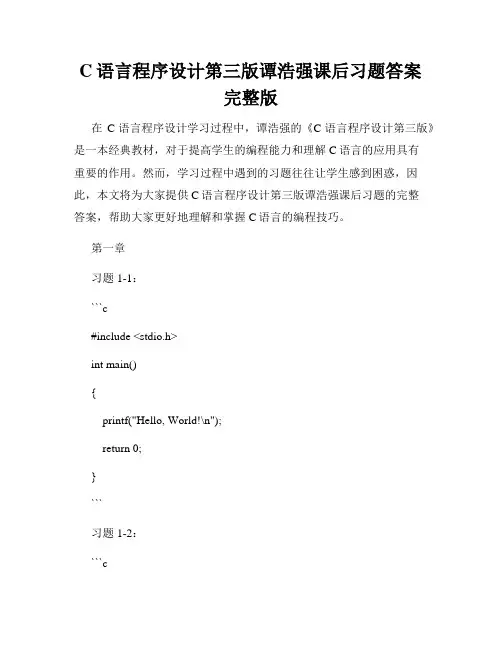
C语言程序设计第三版谭浩强课后习题答案完整版在C语言程序设计学习过程中,谭浩强的《C语言程序设计第三版》是一本经典教材,对于提高学生的编程能力和理解C语言的应用具有重要的作用。
然而,学习过程中遇到的习题往往让学生感到困惑,因此,本文将为大家提供C语言程序设计第三版谭浩强课后习题的完整答案,帮助大家更好地理解和掌握C语言的编程技巧。
第一章习题1-1:```c#include <stdio.h>int main(){printf("Hello, World!\n");return 0;}```习题1-2:```c#include <stdio.h>int main(){printf("天\n地\n人\n"); return 0;}```习题1-3:```c#include <stdio.h>int main(){printf(" *\n");printf(" * *\n");printf(" * *\n");printf(" * *\n");printf(" * *\n");printf("***\n");return 0;}```习题1-4:```c#include <stdio.h>int main(){int height, width, area;height = 8;width = 10;area = height * width;printf("长方形的面积为:%d\n", area); return 0;}```第二章习题2-1:```c#include <stdio.h>int main(){int radius;float pi = 3.14159;printf("请输入半径:");scanf("%d", &radius);float area = pi * radius * radius;printf("圆的面积为:%f\n", area); return 0;}```习题2-2:```c#include <stdio.h>int main(){int length, width, area;printf("请输入长方形的长度:"); scanf("%d", &length);printf("请输入长方形的宽度:");scanf("%d", &width);area = length * width;printf("长方形的面积为:%d\n", area);return 0;}```习题2-3:```c#include <stdio.h>int main(){int num1, num2, num3, sum;printf("请输入三个整数,用空格隔开:"); scanf("%d %d %d", &num1, &num2, &num3); sum = num1 + num2 + num3;printf("三个整数的和为:%d\n", sum);return 0;}习题2-4:```c#include <stdio.h>int main(){int high, price;printf("请输入身高(厘米):"); scanf("%d", &high);price = (high - 100) * 0.9;printf("标准体重为:%d\n", price); return 0;}```第三章习题3-1:```c#include <stdio.h>int main()int i, j;for (i = 1; i <= 9; i++){for (j = 1; j <= i; j++){printf("%d*%d=%2d ", j, i, i * j); }printf("\n");}return 0;}```习题3-2:```c#include <stdio.h>int main(){int n, sum = 0, i;printf("请输入一个整数:");scanf("%d", &n);for (i = 1; i <= n; i++){sum += i;}printf("1到%d的和为:%d\n", n, sum); return 0;}```习题3-3:```c#include <stdio.h>int main(){int n, i;printf("请输入一个整数:");scanf("%d", &n);for (i = 2; i < n; i++){if (n % i == 0){break;}}if (i == n){printf("%d是素数。
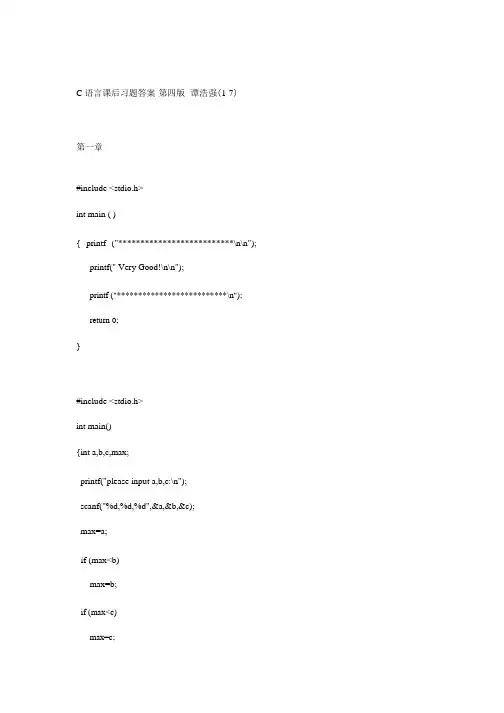
C 语言课后习题答案-第四版- 谭浩强(1-7)第一章#include <stdio.h>int main ( ){ printf ("**************************\n\n");printf(" Very Good!\n\n");printf ("**************************\n");return 0;}#include <stdio.h>int main(){int a,b,c,max;printf("please input a,b,c:\n");scanf("%d,%d,%d",&a,&b,&c);max=a;if (max<b)max=b;if (max<c)max=c;printf("The largest number is %d\n",max); return 0;}第3章#include <stdio.h>#include <math.h>int main(){float p,r,n;r=0.1;n=10;p=pow(1+r,n);printf("p=%f\n",p);return 0;}#include <stdio.h>#include <math.h>int main(){float r5,r3,r2,r1,r0,p,p1,p2,p3,p4,p5;p=1000;r5=0.0585;r3=0.054;r2=0.0468;r1=0.0414;r0=0.0072;p1=p*((1+r5)*5); // 一次存 5 年期p2=p*(1+2*r2)*(1+3*r3); // 先存 2 年期,到期后将本息再存 3 年期p3=p*(1+3*r3)*(1+2*r2); // 先存 3 年期,到期后将本息再存 2 年期p4=p*pow(1+r1,5); // 存 1 年期,到期后将本息存再存 1 年期,连续存 5 次p5=p*pow(1+r0/4,4*5); // 存活期存款。

C语言程序设计课后习题答案谭浩强This model paper was revised by LINDA on December 15, 2012.第1章程序设计和C语言1什么是计算机程序1什么是计算机语言1语言的发展及其特点3最简单的C语言程序5最简单的C语言程序举例6语言程序的结构10运行C程序的步骤与方法12程序设计的任务141-5 #include <>int main ( ){ printf ("**************************\n\n"); printf(" Very Good!\n\n");printf ("**************************\n"); return 0;}1-6#include <>int main(){int a,b,c,max;printf("please input a,b,c:\n");scanf("%d,%d,%d",&a,&b,&c);max=a;if (max<b)max=b;if (max<c)max=c;printf("The largest number is %d\n",max); return 0;}第2章算法——程序的灵魂16什么是算法16简单的算法举例17算法的特性21怎样表示一个算法22用自然语言表示算法22用流程图表示算法22三种基本结构和改进的流程图26用N S流程图表示算法28用伪代码表示算法31用计算机语言表示算法32结构化程序设计方法34习题36第章最简单的C程序设计——顺序程序设计37顺序程序设计举例37数据的表现形式及其运算39常量和变量39数据类型42整型数据44字符型数据47浮点型数据49怎样确定常量的类型51运算符和表达式52语句57语句的作用和分类57最基本的语句——赋值语句59数据的输入输出65输入输出举例65有关数据输入输出的概念67用printf函数输出数据68用scanf函数输入数据75字符数据的输入输出78习题823-1 #include <>#include <>int main(){float p,r,n;r=;n=10;p=pow(1+r,n);printf("p=%f\n",p);return 0;}3-2-1#include <>#include <>int main(){float r5,r3,r2,r1,r0,p,p1,p2,p3,p4,p5; p=1000;r5=;r3=;r2=;r1=;r0=;p1=p*((1+r5)*5); #include <> #include <>int main(){float d=300000,p=6000,r=,m;m=log10(p/(p-d*r))/log10(1+r);printf("m=%\n",m);return 0;}3-4#include <>int main(){int c1,c2;c1=197;c2=198;printf("c1=%c,c2=%c\n",c1,c2);printf("c1=%d,c2=%d\n",c1,c2);return 0;}3-5#include <>int main(){int a,b;float x,y;char c1,c2;scanf("a=%d b=%d",&a,&b);scanf("%f %e",&x,&y);scanf("%c%c",&c1,&c2);printf("a=%d,b=%d,x=%f,y=%f,c1=%c,c2=%c\n",a,b,x,y,c1,c2); return 0;}3-6#include <>int main(){char c1='C',c2='h',c3='i',c4='n',c5='a';c1=c1+4;c2=c2+4;c3=c3+4;c4=c4+4;c5=c5+4;printf("passwor is %c%c%c%c%c\n",c1,c2,c3,c4,c5); return 0;}3-7#include <>int main (){float h,r,l,s,sq,vq,vz;float pi=;printf("请输入圆半径r,圆柱高h∶");scanf("%f,%f",&r,&h); #include <> int main(){ int x,y;printf("输入x:");scanf("%d",&x);if(x<1) /* x<1 */{ y=x;printf("x=%3d, y=x=%d\n" ,x,y);}else if(x<10) /* 1=<x<10 */{ y=2*x-1;printf("x=%d, y=2*x-1=%d\n",x,y);}else /* x>=10 */{ y=3*x-11;printf("x=%d, y=3*x-11=%d\n",x,y); }return 0;}4-7-1#include <>int main(){int x,y;printf("enter x:");scanf("%d",&x);y=-1;if(x!=0)if(x>0)y=1;elsey=0;printf("x=%d,y=%d\n",x,y); return 0;}4-7-2#include <>int main(){int x,y;printf("please enter x:"); scanf("%d",&x);y=0;if(x>=0)if(x>0) y=1;else y=-1;printf("x=%d,y=%d\n",x,y); return 0;}4-8#include <>int main(){ float score;char grade;printf("请输入学生成绩:"); scanf("%f",&score);while (score>100||score<0) {printf("\n 输入有误,请重输"); scanf("%f",&score);}switch((int)(score/10))case 9: grade='A';break;case 8: grade='B';break;case 7: grade='C';break;case 6: grade='D';break;case 5:case 4:case 3:case 2:case 1:case 0: grade='E';}printf("成绩是 %,相应的等级是%c\n ",score,grade); return 0;}4-9#include <>int main(){int num,indiv,ten,hundred,thousand,ten_thousand,place;位,万位和位数printf("请输入一个整数(0-99999):");scanf("%d",&num);if (num>9999)place=5;else if (num>999)place=4;else if (num>99) .=%d\n",sn);return 0;}5-6int main(){double s=0,t=1;int n;for (n=1;n<=20;n++){t=t*n;s=s+t;}printf("1!+2!+...+20!=%\n",s); return 0;}5-7#include <>int main(){int n1=100,n2=50,n3=10;double k,s1=0,s2=0,s3=0;for (k=1;k<=n1;k++) /*计算1到100的和*/{s1=s1+k;}for (k=1;k<=n2;k++) /*计算1到50各数的平方和*/ {s2=s2+k*k;}for (k=1;k<=n3;k++) /*计算1到10的各倒数和*/ {s3=s3+1/k;}printf("sum=%\n",s1+s2+s3);return 0;}5-8#include <>int main(){int i,j,k,n;printf("parcissus numbers are ");for (n=100;n<1000;n++){i=n/100;j=n/10-i*10;k=n%10;if (n==i*i*i + j*j*j + k*k*k)printf("%d ",n);}printf("\n");return 0;}5-9-1#define M 1000 /*定义寻找范围*/ #include <>int main(){int k1,k2,k3,k4,k5,k6,k7,k8,k9,k10;int i,a,n,s;for (a=2;a<=M;a++) /* a是2-1000之间的整数,检查它是否完数 */{n=0; /* n用来累计a的因子的个数 */s=a; /* s用来存放尚未求出的因子之和,开始时等于a */ for (i=1;i<a;i++) /* 检查i是否a的因子 */if (a%i==0) /* 如果i是a的因子 */{n++; /* n加1,表示新找到一个因子 */s=s-i; /* s减去已找到的因子,s的新值是尚未求出的因子之和 */ switch(n) /* 将找到的因子赋给k1...k9,或k10 */{case 1:k1=i; break; /* 找出的笫1个因子赋给k1 */case 2:k2=i; break; /* 找出的笫2个因子赋给k2 */case 3:k3=i; break; /* 找出的笫3个因子赋给k3 */case 4:k4=i; break; /* 找出的笫4个因子赋给k4 */ case 5:k5=i; break; /* 找出的笫5个因子赋给k5 */ case 6:k6=i; break; /* 找出的笫6个因子赋给k6 */ case 7:k7=i; break; /* 找出的笫7个因子赋给k7 */ case 8:k8=i; break; /* 找出的笫8个因子赋给k8 */ case 9:k9=i; break; /*找出的笫9个因子赋给k9 */ case 10:k10=i; break; /* 找出的笫10个因子赋给k10 */ }}{printf("%d ,Its factors are ",a);if (n>1) printf("%d,%d",k1,k2); /* n>1表示a至少有2个因子 */if (n>2) printf(",%d",k3); /* n>2表示至少有3个因子,故应再输出一个因子 */if (n>3) printf(",%d",k4); /* n>3表示至少有4个因子,故应再输出一个因子 */if (n>4) printf(",%d",k5); /* 以下类似 */if (n>5) printf(",%d",k6);if (n>6) printf(",%d",k7);if (n>7) printf(",%d",k8);if (n>8) printf(",%d",k9);if (n>9) printf(",%d",k10);printf("\n");}}}5-9-2#include <>int main(){int m,s,i;for (m=2;m<1000;m++){s=0;for (i=1;i<m;i++)if ((m%i)==0) s=s+i;if(s==m){printf("%d,its factors are ",m); for (i=1;i<m;i++)if (m%i==0) printf("%d ",i); printf("\n");}}return 0;}5-10#include <>int main(){int i,n=20;double a=2,b=1,s=0,t; for (i=1;i<=n;i++){s=s+a/b;t=a,a=a+b,b=t;}printf("sum=%\n",s);return 0;}5-11#include <>int main(){double sn=100,hn=sn/2;int n;for (n=2;n<=10;n++){sn=sn+2*hn; /*第n次落地时共经过的米数*/ hn=hn/2; /*第n次反跳高度*/}printf("第10次落地时共经过%f米\n",sn); printf("第10次反弹%f米\n",hn);return 0;}5-12#include <>int main(){int day,x1,x2;day=9;x2=1;while(day>0){x1=(x2+1)*2; /*第1天的桃子数是第2天桃子数加1后的2倍.*/ x2=x1;day--;}printf("total=%d\n",x1);return 0;}5-13#include <>#include <>int main(){float a,x0,x1;printf("enter a positive number:");scanf("%f",&a);x0=a/2;x1=(x0+a/x0)/2;do{x0=x1;x1=(x0+a/x0)/2;}while(fabs(x0-x1)>=1e-5);printf("The square root of % is %\n",a,x1);return 0;}5-14#include <>#include <>int main(){double x1,x0,f,f1;x1=;do{x0=x1;f=((2*x0-4)*x0+3)*x0-6;f1=(6*x0-8)*x0+3;x1=x0-f/f1;}while(fabs(x1-x0)>=1e-5);printf("The root of equation is %\n",x1); return 0;}5-15#include <>#include <>int main(){float x0,x1,x2,fx0,fx1,fx2; do{printf("enter x1 & x2:"); scanf("%f,%f",&x1,&x2);fx1=x1*((2*x1-4)*x1+3)-6;fx2=x2*((2*x2-4)*x2+3)-6;}while(fx1*fx2>0);do{x0=(x1+x2)/2;fx0=x0*((2*x0-4)*x0+3)-6;if ((fx0*fx1)<0){x2=x0;fx2=fx0;}else{x1=x0;fx1=fx0;}}while(fabs (fx0)>=1e-5); printf("x=%\n",x0);return 0;}5-16#include <>int main(){int i,j,k;for (i=0;i<=3;i++){for (j=0;j<=2-i;j++) printf(" ");for (k=0;k<=2*i;k++) printf("*");printf("\n");}for (i=0;i<=2;i++) {for (j=0;j<=i;j++) printf(" ");for (k=0;k<=4-2*i;k++) printf("*");printf("\n");}return 0;}5-17#include <>int main(){char i,j,k; /*是a的对手;j是b的对手;k是c的对手*/ for (i='x';i<='z';i++)for (j='x';j<='z';j++)if (i!=j)for (k='x';k<='z';k++)if (i!=k && j!=k)if (i!='x' && k!='x' && k!='z')printf("A--%c\nB--%c\nC--%c\n",i,j,k);return 0;}第6章利用数组处理批量数据142怎样定义和引用一维数组142怎样定义一维数组143怎样引用一维数组元素144一维数组的初始化145一维数组程序举例146怎样定义和引用二维数组148怎样定义二维数组149怎样引用二维数组的元素150二维数组的初始化151二维数组程序举例152字符数组154怎样定义字符数组154字符数组的初始化155怎样引用字符数组中的元素155字符串和字符串结束标志156字符数组的输入输出159使用字符串处理函数161字符数组应用举例165习题1686-1#include <>#include <>int main(){int i,j,n,a[101];for (i=1;i<=100;i++)a[i]=i;a[1]=0;for (i=2;i<sqrt(100);i++) for (j=i+1;j<=100;j++) {if(a[i]!=0 && a[j]!=0) if (a[j]%a[i]==0)a[j]=0;}printf("\n");for (i=2,n=0;i<=100;i++) { if(a[i]!=0){printf("%5d",a[i]);n++;}if(n==10){printf("\n");n=0;}}printf("\n");return 0;}6-2#include <>int main(){int i,j,min,temp,a[11];printf("enter data:\n");for (i=1;i<=10;i++){printf("a[%d]=",i);scanf("%d",&a[i]);}printf("\n");printf("The orginal numbers:\n"); for (i=1;i<=10;i++)printf("%5d",a[i]);printf("\n");for (i=1;i<=9;i++){min=i;for (j=i+1;j<=10;j++)if (a[min]>a[j]) min=j;temp=a[i];a[i]=a[min];a[min]=temp;}printf("\nThe sorted numbers:\n"); for (i=1;i<=10;i++)printf("%5d",a[i]);printf("\n");return 0;}6-3#include <>int main(){int a[3][3],sum=0;int i,j;printf("enter data:\n");for (i=0;i<3;i++)for (j=0;j<3;j++)scanf("%3d",&a[i][j]);for (i=0;i<3;i++)sum=sum+a[i][i];printf("sum=%6d\n",sum);return 0;}6-4#include <>int main(){ int a[11]={1,4,6,9,13,16,19,28,40,100}; int temp1,temp2,number,end,i,j;printf("array a:\n");for (i=0;i<10;i++)printf("%5d",a[i]);printf("\n");printf("insert data:"); scanf("%d",&number); end=a[9];if (number>end)a[10]=number;else{for (i=0;i<10;i++){if (a[i]>number) {temp1=a[i];a[i]=number;for (j=i+1;j<11;j++) {temp2=a[j];a[j]=temp1;temp1=temp2;}break;}}}printf("Now array a:\n"); for (i=0;i<11;i++)printf("%5d",a[i]);printf("\n");return 0;}6-5#include <>#define N 5int main(){ int a[N],i,temp;printf("enter array a:\n");for (i=0;i<N;i++)scanf("%d",&a[i]);printf("array a:\n");for (i=0;i<N;i++)printf("%4d",a[i]);for (i=0;i<N/2;i++) n",number);; printf("continu or not(Y/N)");scanf(" %c",&c);if (c=='N'||c=='n')flag=0;}return 0;}6-10#include <>int main(){int i,j,upp,low,dig,spa,oth;char text[3][80];upp=low=dig=spa=oth=0;for (i=0;i<3;i++){ printf("please input line %d:\n",i+1);gets(text[i]);for (j=0;j<80 && text[i][j]!='\0';j++){if (text[i][j]>='A'&& text[i][j]<='Z')upp++;else if (text[i][j]>='a' && text[i][j]<='z') low++; else if (text[i][j]>='0' && text[i][j]<='9') dig++; else if (text[i][j]==' ')spa++;elseoth++;}}printf("\nupper case: %d\n",upp); printf("lower case: %d\n",low); printf("digit : %d\n",dig); printf("space : %d\n",spa); printf("other : %d\n",oth); return 0;}6-11#include <>int main(){ char a[5]={'*','*','*','*','*'}; int i,j,k;char space=' ';for (i=0;i<5;i++){ printf("\n");printf(" ");for (j=1;j<=i;j++)printf("%c",space);for (k=0;k<5;k++)printf("%c",a[k]);}printf("\n");return 0;}6-12a-c#include <>int main(){ int j,n;char ch[80],tran[80];printf("input cipher code:"); gets(ch);printf("\ncipher code :%s",ch);j=0;while (ch[j]!='\0'){ if ((ch[j]>='A') && (ch[j]<='Z')) tran[j]=155-ch[j];else if ((ch[j]>='a') && (ch[j]<='z')) tran[j]=219-ch[j];elsetran[j]=ch[j];j++;}n=j;printf("\noriginal text:");for (j=0;j<n;j++)putchar(tran[j]);printf("\n");return 0;}6-12b#include <>int main(){int j,n;char ch[80];printf("input cipher code:\n");gets(ch);printf("\ncipher code:%s\n",ch);j=0;while (ch[j]!='\0'){ if ((ch[j]>='A') && (ch[j]<='Z'))ch[j]=155-ch[j];else if ((ch[j]>='a') && (ch[j]<='z')) ch[j]=219-ch[j];elsech[j]=ch[j];j++;}n=j;printf("original text:"); for (j=0;j<n;j++)putchar(ch[j]);printf("\n");return 0;}6-13#include <>int main(){ char s1[80],s2[40];int i=0,j=0;printf("input string1:");scanf("%s",s1);printf("input string2:");scanf("%s",s2);while (s1[i]!='\0')i++;while(s2[j]!='\0')s1[i++]=s2[j++];s1[i]='\0';printf("\nThe new string is:%s\n",s1); return 0;}6-14#include <>int main(){ int i,resu;char s1[100],s2[100];printf("input string1:");gets(s1);printf("\ninput string2:");gets(s2);i=0;while ((s1[i]==s2[i]) && (s1[i]!='\0'))i++; if (s1[i]=='\0' && s2[i]=='\0')resu=0;elseresu=s1[i]-s2[i];printf("\nresult:%d.\n",resu);return 0;}6-15#include <>#include <>int main(){ char s1[80],s2[80];int i;printf("input s2:");scanf("%s",s2);for (i=0;i<=strlen(s2);i++)s1[i]=s2[i];printf("s1:%s\n",s1);return 0;}第7章用函数实现模块化程序设计170为什么要用函数170怎样定义函数172为什么要定义函数172定义函数的方法173调用函数174函数调用的形式174函数调用时的数据传递175函数调用的过程177函数的返回值178对被调用函数的声明和函数原型179函数的嵌套调用182函数的递归调用184数组作为函数参数192数组元素作函数实参193数组名作函数参数194多维数组名作函数参数197局部变量和全局变量199局部变量199全局变量200变量的存储方式和生存期204。

谭浩强c++程序设计课后答案娄警卫第一章1.5题#include <iostream> using namespace std; int main(){cout<<"This"<<"is"; cout<<"a"<<"C++"; cout<<"program."; return 0;1.6题#include <iostream> using namespace std; int main(){int a,b,c;a=10;b=23;c=a+b;cout<<"a+b="; cout<<c;cout<<endl;return 0;}1.7七题#include <iostream> using namespace std; int main(){int a,b,c;int f(int x,int y,int z); cin>>a>>b>>c;c=f(a,b,c);cout<<c<<endl; return 0;}int f(int x,int y,int z) {int m;if (x<y) m=x;else m=y;if (z<m) m=z;return(m);}1.8题#include <iostream>using namespace std;int main(){int a,b,c;cin>>a>>b;c=a+b;cout<<"a+b="<<a+b<<endl; return 0;}1.9题#include <iostream>using namespace std;int main(){int a,b,c;int add(int x,int y); cin>>a>>b;c=add(a,b);cout<<"a+b="<<c<<endl; return 0;}int add(int x,int y){int z;z=x+y;return(z);}第二章2.3题#include <iostream>using namespace std;int main(){char c1='a',c2='b',c3='c',c4='\101',c5='\116'; cout<<c1<<c2<<c3<<'\n';cout<<"\t\b"<<c4<<'\t'<<c5<<'\n';return 0;}2.4题#include <iostream>using namespace std;int main(){char c1='C',c2='+',c3='+';cout<<"I say: \""<<c1<<c2<<c3<<'\"';cout<<"\t\t"<<"He says: \"C++ is very interesting!\""<< '\n';return 0;}2.7题#include <iostream>using namespace std;int main(){int i,j,m,n;i=8;j=10;m=++i+j++;n=(++i)+(++j)+m;cout<<i<<'\t'<<j<<'\t'<<m<<'\t'<<n<<endl; return 0;}2.8题#include <iostream>using namespace std;int main(){char c1='C', c2='h', c3='i', c4='n', c5='a';c1+=4;c2+=4;c3+=4;c4+=4;c5+=4;cout<<"password is:"<<c1<<c2<<c3<<c4<<c5<<endl;return 0;}第三章3.2题#include <iostream>#include <iomanip>using namespace std;int main ( ){float h,r,l,s,sq,vq,vz;const float pi=3.1415926;cout<<"please enter r,h:";cin>>r>>h;l=2*pi*r;s=r*r*pi;sq=4*pi*r*r;vq=3.0/4.0*pi*r*r*r;vz=pi*r*r*h;cout<<setiosflags(ios::fixed)<<setiosflags(ios:: right)<<setprecision(2);cout<<"l= "<<setw(10)<<l<<endl;cout<<"s= "<<setw(10)<<s<<endl;cout<<"sq="<<setw(10)<<sq<<endl;cout<<"vq="<<setw(10)<<vq<<endl;cout<<"vz="<<setw(10)<<vz<<endl;return 0;}3.3题#include <iostream>using namespace std;int main (){float c,f;cout<<"请输入一个华氏温度:";cin>>f;c=(5.0/9.0)*(f-32); //注意5和9要用实型表示,否则5/9值为0cout<<"摄氏温度为:"<<c<<endl;return 0;};3.4题#include <iostream>using namespace std;int main ( ){char c1,c2;cout<<"请输入两个字符c1,c2:";c1=getchar(); //将输入的第一个字符赋给c1c2=getchar(); //将输入的第二个字符赋给c2cout<<"用putchar函数输出结果为:"; putchar(c1);putchar(c2);cout<<endl;cout<<"用cout语句输出结果为:";cout<<c1<<c2<<endl;return 0;}3.4题另一解#include <iostream>using namespace std;int main ( ){char c1,c2;cout<<"请输入两个字符c1,c2:";c1=getchar(); //将输入的第一个字符赋给c1c2=getchar(); //将输入的第二个字符赋给c2cout<<"用putchar函数输出结果为:"; putchar(c1);putchar(44);putchar(c2);cout<<endl;cout<<"用cout语句输出结果为:";cout<<c1<<","<<c2<<endl;return 0;}3.5题#include <iostream>using namespace std;int main ( ){char c1,c2;int i1,i2; //定义为整型cout<<"请输入两个整数i1,i2:";cin>>i1>>i2;c1=i1;c2=i2;cout<<"按字符输出结果为:"<<c1<<" , "<<c2<<endl;return 0;}3.8题#include <iostream>using namespace std;int main ( ){ int a=3,b=4,c=5,x,y;cout<<(a+b>c && b==c)<<endl;cout<<(a||b+c && b-c)<<endl;cout<<(!(a>b) && !c||1)<<endl;cout<<(!(x=a) && (y=b) && 0)<<endl;cout<<(!(a+b)+c-1 && b+c/2)<<endl; return 0;}3.9题include <iostream>using namespace std;int main ( ){int a,b,c;cout<<"please enter three integer numbers:";cin>>a>>b>>c;if(a<b)if(b<c)cout<<"max="<<c;elsecout<<"max="<<b;else if (a<c)cout<<"max="<<c;elsecout<<"max="<<a;cout<<endl;return 0;}3.9题另一解#include <iostream>using namespace std;int main ( ){int a,b,c,temp,max ;cout<<"please enter three integer numbers:";cin>>a>>b>>c;temp=(a>b)?a:b; /* 将a和b中的大者存入temp中*/max=(temp>c)?temp:c; /* 将a和b中的大者与c比较,最大者存入max*/cout<<"max="<<max<<endl;return 0;}3.10题#include <iostream>using namespace std;int main ( ){int x,y;cout<<"enter x:";cin>>x;if (x<1){y=x;cout<<"x="<<x<<", y=x="<<y;}else if (x<10) // 1≤x<10{y=2*x-1;cout<<"x="<<x<<", y=2*x-1="<<y;}else// x≥10{y=3*x-11;cout<<"x="<<x<<",y=3*x-11="<<y;}cout<<endl;return 0;}3.11题#include <iostream>using namespace std; int main (){float score;char grade;cout<<"please enter score of student:"; cin>>score;while (score>100||score<0){cout<<"data error,enter data again.";cin>>score;}switch(int(score/10)){case 10:case 9: grade='A';break;case 8: grade='B';break;case 7: grade='C';break;case 6: grade='D';break;default:grade='E';}cout<<"score is "<<score<<", grade is "<<grade<<endl;return 0;}3.12题#include <iostream>using namespace std;int main (){long int num;intindiv,ten,hundred,thousand,ten_thousand,pla ce;/*分别代表个位,十位,百位,千位,万位和位数*/cout<<"enter an integer(0~99999):"; cin>>num;if (num>9999)place=5;else if (num>999)place=4;else if (num>99)place=3;else if (num>9)place=2;else place=1;cout<<"place="<<place<<endl;//计算各位数字ten_thousand=num/10000;thousand=(int)(num-ten_thousand*10000)/1 000;hundred=(int)(num-ten_thousand*10000-tho usand*1000)/100;ten=(int)(num-ten_thousand*10000-thousan d*1000-hundred*100)/10;indiv=(int)(num-ten_thousand*10000-thousa nd*1000-hundred*100-ten*10);cout<<"original order:";switch(place){case5:cout<<ten_thousand<<","<<thousand<<","< <hundred<<","<<ten<<","<<indiv<<endl;cout<<"reverse order:";cout<<indiv<<ten<<hundred<<thousand<<ten _thousand<<endl;break;case4:cout<<thousand<<","<<hundred<<","<<ten <<","<<indiv<<endl;cout<<"reverse order:";cout<<indiv<<ten<<hundred<<thousand<<en dl;break;case3:cout<<hundred<<","<<ten<<","<<indiv<<en dl;cout<<"reverse order:";cout<<indiv<<ten<<hundred<<endl;break;case 2:cout<<ten<<","<<indiv<<endl;cout<<"reverse order:";cout<<indiv<<ten<<endl;break;case 1:cout<<indiv<<endl;cout<<"reverse order:";cout<<indiv<<endl;break;}return 0;}3.13题#include <iostream>using namespace std;int main (){ long i; //i为利润floatbonus,bon1,bon2,bon4,bon6,bon10;bon1=100000*0.1; //利润为10万元时的奖金bon2=bon1+100000*0.075; //利润为20万元时的奖金bon4=bon2+100000*0.05; //利润为40万元时的奖金bon6=bon4+100000*0.03; //利润为60万元时的奖金bon10=bon6+400000*0.015; //利润为100万元时的奖金cout<<"enter i:";cin>>i;if (i<=100000)bonus=i*0.1;//利润在10万元以内按10%提成奖金else if (i<=200000)bonus=bon1+(i-100000)*0.075; //利润在10万元至20万时的奖金else if (i<=400000)bonus=bon2+(i-200000)*0.05; //利润在20万元至40万时的奖金else if (i<=600000)bonus=bon4+(i-400000)*0.03; //利润在40万元至60万时的奖金else if (i<=1000000)bonus=bon6+(i-600000)*0.015; //利润在60万元至100万时的奖金elsebonus=bon10+(i-1000000)*0.01; //利润在100万元以上时的奖金cout<<"bonus="<<bonus<<endl;return 0;}3.13题另一解#include <iostream>using namespace std;int main (){long i;float bonus,bon1,bon2,bon4,bon6,bon10; int c;bon1=100000*0.1;bon2=bon1+100000*0.075;bon4=bon2+200000*0.05;bon6=bon4+200000*0.03;bon10=bon6+400000*0.015;cout<<"enter i:";cin>>i;c=i/100000;if (c>10) c=10;switch(c){case 0: bonus=i*0.1; break;case 1: bonus=bon1+(i-100000)*0.075; break;case 2:case3:bonus=bon2+(i-200000)*0.05;break;case 4:case5:bonus=bon4+(i-400000)*0.03;break;case 6:case 7:case 8:case 9: bonus=bon6+(i-600000)*0.015; break;case 10: bonus=bon10+(i-1000000)*0.01;}cout<<"bonus="<<bonus<<endl;return 0;}3.14题#include <iostream>using namespace std;int main (){int t,a,b,c,d;cout<<"enter four numbers:";cin>>a>>b>>c>>d;cout<<"a="<<a<<", b="<<b<<", c="<<c<<",d="<<d<<endl;if (a>b){t=a;a=b;b=t;}if (a>c){t=a; a=c; c=t;}if (a>d){t=a; a=d; d=t;}if (b>c){t=b; b=c; c=t;}if (b>d){t=b; b=d; d=t;}if (c>d){t=c; c=d; d=t;}cout<<"the sorted sequence:"<<endl;cout<<a<<", "<<b<<", "<<c<<", "<<d<<endl; return 0;}3.15题#include <iostream>using namespace std;int main (){int p,r,n,m,temp;cout<<"please enter two positive integer numbers n,m:";cin>>n>>m;if (n<m){temp=n;n=m;m=temp; //把大数放在n中, 小数放在m中}p=n*m; //先将n和m的乘积保存在p中, 以便求最小公倍数时用while (m!=0) //求n和m的最大公约数{r=n%m;n=m;m=r;}cout<<"HCF="<<n<<endl;cout<<"LCD="<<p/n<<endl; // p是原来两个整数的乘积return 0;}3.16题#include <iostream>using namespace std;int main (){char c;int letters=0,space=0,digit=0,other=0;cout<<"enter one line::"<<endl;while((c=getchar())!='\n'){if (c>='a' && c<='z'||c>='A' && c<='Z')letters++;else if (c==' ')space++;else if (c>='0' && c<='9')digit++;elseother++;}cout<<"letter:"<<letters<<", space:"<<space<<", digit:"<<digit<<", other:"<<other<<endl;return 0;}3.17题#include <iostream>using namespace std;int main (){int a,n,i=1,sn=0,tn=0;cout<<"a,n=:";cin>>a>>n;while (i<=n){tn=tn+a; //赋值后的tn为i个a 组成数的值sn=sn+tn; //赋值后的sn为多项式前i项之和a=a*10;++i;}cout<<"a+aa+aaa+...="<<sn<<endl;return 0;}3.18题#include <iostream>using namespace std;int main (){float s=0,t=1;int n;for (n=1;n<=20;n++){t=t*n; // 求n!s=s+t; // 将各项累加}cout<<"1!+2!+...+20!="<<s<<endl;return 0;}3.19题#include <iostream>using namespace std;int main (){int i,j,k,n;cout<<"narcissus numbers are:"<<endl;for (n=100;n<1000;n++){i=n/100;j=n/10-i*10;k=n%10;if (n == i*i*i + j*j*j + k*k*k)cout<<n<<" ";}cout<<endl;return 0;}3.20题#include <iostream>using namespace std;int main(){const int m=1000; // 定义寻找范围int k1,k2,k3,k4,k5,k6,k7,k8,k9,k10;int i,a,n,s;for (a=2;a<=m;a++) // a是2~1000之间的整数,检查它是否为完数{n=0; // n用来累计a的因子的个数s=a; // s用来存放尚未求出的因子之和,开始时等于afor (i=1;i<a;i++) // 检查i是否为a 的因子if (a%i==0) // 如果i是a的因子{n++; // n加1,表示新找到一个因子s=s-i; // s减去已找到的因子,s的新值是尚未求出的因子之和switch(n) // 将找到的因子赋给k1,...,k10{case 1:k1=i; break; // 找出的笫1个因子赋给k1case 2:k2=i; break; // 找出的笫2个因子赋给k2case 3:k3=i; break; // 找出的笫3个因子赋给k3case 4:k4=i; break; // 找出的笫4个因子赋给k4case 5:k5=i; break; // 找出的笫5个因子赋给k5case 6:k6=i; break; // 找出的笫6个因子赋给k6case 7:k7=i; break; // 找出的笫7个因子赋给k7case 8:k8=i; break; // 找出的笫8个因子赋给k8case 9:k9=i; break; // 找出的笫9个因子赋给k9case 10:k10=i; break; // 找出的笫10个因子赋给k10}}if (s==0) // s=0表示全部因子都已找到了{cout<<a<<" is a 完数"<<endl;cout<<"its factors are:";if (n>1) cout<<k1<<","<<k2; // n>1表示a至少有2个因子if (n>2) cout<<","<<k3; // n>2表示至少有3个因子,故应再输出一个因子if (n>3) cout<<","<<k4; // n>3表示至少有4个因子,故应再输出一个因子if (n>4) cout<<","<<k5; // 以下类似if (n>5) cout<<","<<k6;if (n>6) cout<<","<<k7;if (n>7) cout<<","<<k8;if (n>8) cout<<","<<k9;if (n>9) cout<<","<<k10;cout<<endl<<endl;}}return 0;}3.20题另一解#include <iostream>using namespace std;int main(){int m,s,i;for (m=2;m<1000;m++){s=0;for (i=1;i<m;i++)if ((m%i)==0) s=s+i;if(s==m){cout<<m<<" is a完数"<<endl;cout<<"its factors are:";for (i=1;i<m;i++)if (m%i==0) cout<<i<<" ";cout<<endl;}}return 0;}3.20题另一解#include <iostream>using namespace std;int main(){int k[11];int i,a,n,s;for (a=2;a<=1000;a++){n=0;s=a;for (i=1;i<a;i++)if ((a%i)==0){n++;s=s-i;k[n]=i; // 将找到的因子赋给k[1]┅k[10]}if (s==0){cout<<a<<" is a 完数"<<endl;cout<<"its factors are:";for (i=1;i<n;i++)cout<<k[i]<<" ";cout<<k[n]<<endl;}}return 0;}3.21题#include <iostream>using namespace std;int main(){int i,t,n=20;double a=2,b=1,s=0;for (i=1;i<=n;i++){s=s+a/b;t=a;a=a+b; // 将前一项分子与分母之和作为下一项的分子b=t; // 将前一项的分子作为下一项的分母}cout<<"sum="<<s<<endl;return 0;} 3.22题#include <iostream>using namespace std;int main(){int day,x1,x2;day=9;x2=1;while(day>0){x1=(x2+1)*2; // 第1天的桃子数是第2天桃子数加1后的2倍x2=x1;day--;}cout<<"total="<<x1<<endl;return 0;}3.23题#include <iostream>#include <cmath>using namespace std;int main(){float a,x0,x1;cout<<"enter a positive number:"; cin>>a; // 输入a的值x0=a/2;x1=(x0+a/x0)/2;do{x0=x1;x1=(x0+a/x0)/2;}while(fabs(x0-x1)>=1e-5);cout<<"The square root of "<<a<<" is "<<x1<<endl;return 0;}3.24题#include <iostream>using namespace std;int main(){int i,k;for (i=0;i<=3;i++) // 输出上面4行*号{for (k=0;k<=2*i;k++)cout<<"*"; // 输出*号cout<<endl; //输出完一行*号后换行}for (i=0;i<=2;i++) // 输出下面3行*号{for (k=0;k<=4-2*i;k++)cout<<"*"; // 输出*号cout<<endl; // 输出完一行*号后换行}return 0;}3.25题#include <iostream>using namespace std;int main(){char i,j,k; /* i是a的对手;j是b的对手;k是c的对手*/for (i='X';i<='Z';i++)for (j='X';j<='Z';j++)if (i!=j)for (k='X';k<='Z';k++)if (i!=k && j!=k)if (i!='X' && k!='X' && k!='Z')cout<<"A--"<<i<<"B--"<<j<<" C--"<<k<<endl;return 0;}第四章4.1题#include <iostream>using namespace std;int main(){int hcf(int,int);int lcd(int,int,int);int u,v,h,l;cin>>u>>v;h=hcf(u,v);cout<<"H.C.F="<<h<<endl;l=lcd(u,v,h);cout<<"L.C.D="<<l<<endl;return 0;}int hcf(int u,int v){int t,r;if (v>u){t=u;u=v;v=t;}while ((r=u%v)!=0){u=v;v=r;}return(v);}int lcd(int u,int v,int h){return(u*v/h);}4.2题#include <iostream>#include <math.h>using namespace std;float x1,x2,disc,p,q;int main(){void greater_than_zero(float,float); void equal_to_zero(float,float);void smaller_than_zero(float,float); float a,b,c;cout<<"input a,b,c:";cin>>a>>b>>c;disc=b*b-4*a*c;cout<<"root:"<<endl;if (disc>0){greater_than_zero(a,b);cout<<"x1="<<x1<<",x2="<<x2<<endl; }else if (disc==0){equal_to_zero(a,b);cout<<"x1="<<x1<<",x2="<<x2<<endl;}else{smaller_than_zero(a,b);cout<<"x1="<<p<<"+"<<q<<"i"<<endl;cout<<"x2="<<p<<"-"<<q<<"i"<<endl;}return 0;}void greater_than_zero(float a,float b) /* 定义一个函数,用来求disc>0时方程的根*/{x1=(-b+sqrt(disc))/(2*a);x2=(-b-sqrt(disc))/(2*a);}void equal_to_zero(float a,float b) /* 定义一个函数,用来求disc=0时方程的根*/{x1=x2=(-b)/(2*a);}void smaller_than_zero(float a,float b) /* 定义一个函数,用来求disc<0时方程的根*/{p=-b/(2*a);q=sqrt(-disc)/(2*a);}4.3题#include <iostream>using namespace std;int main(){int prime(int); /* 函数原型声明*/int n;cout<<"input an integer:";cin>>n;if (prime(n))cout<<n<<" is a prime."<<endl;elsecout<<n<<" is not a prime."<<endl;return 0;}int prime(int n){int flag=1,i;for (i=2;i<n/2 && flag==1;i++)if (n%i==0)flag=0;return(flag);}4.4题#include <iostream>using namespace std;int main(){int fac(int);int a,b,c,sum=0;cout<<"enter a,b,c:";cin>>a>>b>>c;sum=sum+fac(a)+fac(b)+fac(c);cout<<a<<"!+"<<b<<"!+"<<c<<"!="<<sum<<e ndl;return 0;}int fac(int n){int f=1;for (int i=1;i<=n;i++)f=f*i;return f;}4.5题#include <iostream>#include <cmath>using namespace std;int main(){double e(double);double x,sinh;cout<<"enter x:";cin>>x;sinh=(e(x)+e(-x))/2;cout<<"sinh("<<x<<")="<<sinh<<endl;return 0;}double e(double x){return exp(x);}4.6题#include <iostream>#include <cmath>using namespace std;int main(){doublesolut(double ,double ,double ,double ); double a,b,c,d;cout<<"input a,b,c,d:";cin>>a>>b>>c>>d;cout<<"x="<<solut(a,b,c,d)<<endl;return 0;}double solut(double a,double b,double c,double d){double x=1,x0,f,f1;do{x0=x;f=((a*x0+b)*x0+c)*x0+d;f1=(3*a*x0+2*b)*x0+c;x=x0-f/f1;}while(fabs(x-x0)>=1e-5);return(x);}4.7题#include <iostream>#include <cmath>using namespace std;int main(){void godbaha(int);int n;cout<<"input n:";cin>>n;godbaha(n);return 0;}void godbaha(int n){int prime(int);int a,b;for(a=3;a<=n/2;a=a+2){if(prime(a)){b=n-a;if (prime(b))cout<<n<<"="<<a<<"+"<<b<<endl;}}}int prime(int m){int i,k=sqrt(m);for(i=2;i<=k;i++)if(m%i==0) break;if (i>k) return 1;else return 0;}4.8题#include <iostream>using namespace std;int main(){int x,n;float p(int,int);cout<<"input n & x:";cin>>n>>x;cout<<"n="<<n<<",x="<<x<<endl;;cout<<"P"<<n<<"(x)="<<p(n,x)<<endl; return 0;}float p(int n,int x){if (n==0)return(1);else if (n==1)return(x);elsereturn(((2*n-1)*x*p((n-1),x)-(n-1)*p((n-2),x))/n);}4.9题#include <iostream>using namespace std;int main(){void hanoi(int n,char one,char two,char three);int m;cout<<"input the number of diskes:"; cin>>m;cout<<"The steps of moving "<<m<<" disks:"<<endl;hanoi(m,'A','B','C');return 0;}void hanoi(int n,char one,char two,char three) //将n个盘从one座借助two座,移到three座{void move(char x,char y);if(n==1) move(one,three);else{hanoi(n-1,one,three,two);move(one,three);hanoi(n-1,two,one,three);}}void move(char x,char y){cout<<x<<"-->"<<y<<endl;}4.10题#include <iostream>using namespace std;int main(){void convert(int n);int number;cout<<"input an integer:";cin>>number;cout<<"output:"<<endl;if (number<0){cout<<"-";number=-number;}convert(number);cout<<endl;return 0;}void convert(int n){int i;char c;if ((i=n/10)!=0)convert(i);c=n%10+'0';cout<<" "<<c;}4.11题#include <iostream>using namespace std;int main(){int f(int);int n,s;cout<<"input the number n:";cin>>n;s=f(n);cout<<"The result is "<<s<<endl;return 0;}int f(int n){;if (n==1)return 1;elsereturn (n*n+f(n-1));}4.12题#include <iostream>#include <cmath>using namespace std;#define S(a,b,c) (a+b+c)/2#define AREA(a,b,c)sqrt(S(a,b,c)*(S(a,b,c)-a)*(S(a,b,c)-b)*(S(a,b,c) -c))int main(){float a,b,c;cout<<"input a,b,c:";cin>>a>>b>>c;if (a+b>c && a+c>b && b+c>a)cout<<"area="<<AREA(a,b,c)<<endl; elsecout<<"It is not a triangle!"<<endl; return 0;}4.14题#include <iostream>using namespace std;//#define LETTER 1int main(){char c;cin>>c;#if LETTERif(c>='a' && c<='z')c=c-32;#elseif(c>='A' && c<='Z')c=c+32;#endifcout<<c<<endl;return 0;}4.15题#include <iostream>using namespace std;#define CHANGE 1int main(){char ch[40];cout<<"input text:"<<endl;;gets(ch);#if (CHANGE){for (int i=0;i<40;i++){if (ch[i]!='\0')if (ch[i]>='a'&& ch[i]<'z'||ch[i]>'A'&& ch[i]<'Z')ch[i]+=1;else if (ch[i]=='z'||ch[i]=='Z')ch[i]-=25;}}#endifcout<<"output:"<<endl<<ch<<endl;return 0;}4.16题file#include <iostream>using namespace std;int a;int main(){extern int power(int);int b=3,c,d,m;cout<<"enter an integer a and its power m:"<<endl;cin>>a>>m;c=a*b;cout<<a<<"*"<<b<<"="<<c<<endl;d=power(m);cout<<a<<"**"<<m<<"="<<d<<endl; return 0;}4.16题fileextern int a;int power(int n){int i,y=1;for(i=1;i<=n;i++)y*=a;return y;}第五章5.1题#include <iostream>#include <iomanip>using namespace std;#include <math.h>int main(){int i,j,n,a[101];for (i=1;i<=100;i++)a[i]=i;a[1]=0;for (i=2;i<sqrt(100);i++)for (j=i+1;j<=100;j++){if(a[i]!=0 && a[j]!=0)if (a[j]%a[i]==0)a[j]=0; }cout<<endl;for (i=1,n=0;i<=100;i++){if (a[i]!=0){cout<<setw(5)<<a[i]<<" ";n++;}if(n==10){cout<<endl;n=0;}}cout<<endl;return 0;}5.2题#include <iostream>using namespace std;//#include <math.h>int main(){int i,j,min,temp,a[11];cout<<"enter data:"<<endl;for (i=1;i<=10;i++){cout<<"a["<<i<<"]=";cin>>a[i]; //输入10个数}cout<<endl<<"The original numbers:"<<endl;;for (i=1;i<=10;i++)cout<<a[i]<<" "; // 输出这10个数cout<<endl;;for (i=1;i<=9;i++) //以下8行是对10个数排序{min=i;for (j=i+1;j<=10;j++)if (a[min]>a[j]) min=j;temp=a[i]; //以下3行将a[i+1]~a[10]中最小者与a[i] 对换a[i]=a[min];a[min]=temp;}cout<<endl<<"The sorted numbers:"<<endl;for (i=1;i<=10;i++) // 输出已排好序的10个数cout<<a[i]<<" ";cout<<endl;return 0;}5.3题#include <iostream>using namespace std;int main(){int a[3][3],sum=0;int i,j;cout<<"enter data:"<<endl;;for (i=0;i<3;i++)for (j=0;j<3;j++)cin>>a[i][j];for (i=0;i<3;i++)sum=sum+a[i][i];cout<<"sum="<<sum<<endl;return 0;}5.4题#include <iostream>using namespace std;int main(){int a[11]={1,4,6,9,13,16,19,28,40,100};int num,i,j;cout<<"array a:"<<endl;for (i=0;i<10;i++)cout<<a[i]<<" ";cout<<endl;;cout<<"insert data:";cin>>num;if (num>a[9])a[10]=num;else。
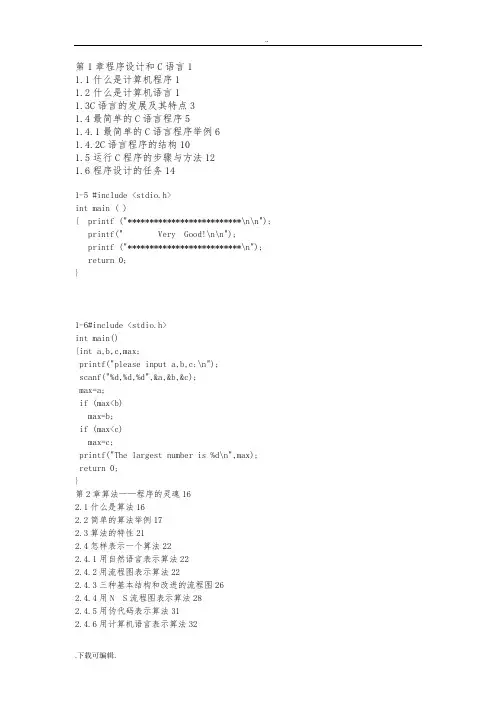
第1章程序设计和C语言11.1什么是计算机程序11.2什么是计算机语言11.3C语言的发展及其特点31.4最简单的C语言程序51.4.1最简单的C语言程序举例61.4.2C语言程序的结构101.5运行C程序的步骤与方法121.6程序设计的任务141-5 #include <stdio.h>int main ( ){ printf ("**************************\n\n"); printf(" Very Good!\n\n");printf ("**************************\n"); return 0;}1-6#include <stdio.h>int main(){int a,b,c,max;printf("please input a,b,c:\n");scanf("%d,%d,%d",&a,&b,&c);max=a;if (max<b)max=b;if (max<c)max=c;printf("The largest number is %d\n",max);return 0;}第2章算法——程序的灵魂162.1什么是算法162.2简单的算法举例172.3算法的特性212.4怎样表示一个算法222.4.1用自然语言表示算法222.4.2用流程图表示算法222.4.3三种基本结构和改进的流程图262.4.4用N S流程图表示算法282.4.5用伪代码表示算法312.4.6用计算机语言表示算法322.5结构化程序设计方法34习题36第章最简单的C程序设计——顺序程序设计37 3.1顺序程序设计举例373.2数据的表现形式及其运算393.2.1常量和变量393.2.2数据类型423.2.3整型数据443.2.4字符型数据473.2.5浮点型数据493.2.6怎样确定常量的类型513.2.7运算符和表达式523.3C语句573.3.1C语句的作用和分类573.3.2最基本的语句——赋值语句593.4数据的输入输出653.4.1输入输出举例653.4.2有关数据输入输出的概念673.4.3用printf函数输出数据683.4.4用scanf函数输入数据753.4.5字符数据的输入输出78习题823-1 #include <stdio.h>#include <math.h>int main(){float p,r,n;r=0.1;n=10;p=pow(1+r,n);printf("p=%f\n",p);return 0;}3-2-1#include <stdio.h>#include <math.h>int main(){float r5,r3,r2,r1,r0,p,p1,p2,p3,p4,p5; p=1000;r5=0.0585;r3=0.054;r2=0.0468;r1=0.0414;r0=0.0072;p1=p*((1+r5)*5); // 一次存5年期p2=p*(1+2*r2)*(1+3*r3); // 先存2年期,到期后将本息再存3年期p3=p*(1+3*r3)*(1+2*r2); // 先存3年期,到期后将本息再存2年期p4=p*pow(1+r1,5); // 存1年期,到期后将本息存再存1年期,连续存5次 p5=p*pow(1+r0/4,4*5); // 存活期存款。
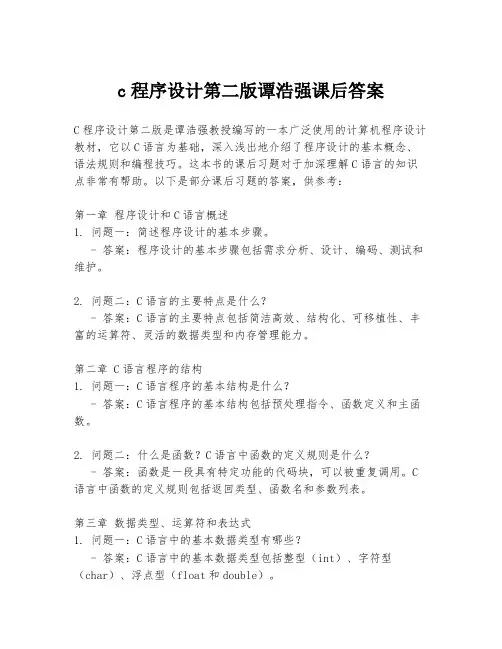
c程序设计第二版谭浩强课后答案C程序设计第二版是谭浩强教授编写的一本广泛使用的计算机程序设计教材,它以C语言为基础,深入浅出地介绍了程序设计的基本概念、语法规则和编程技巧。
这本书的课后习题对于加深理解C语言的知识点非常有帮助。
以下是部分课后习题的答案,供参考:第一章程序设计和C语言概述1. 问题一:简述程序设计的基本步骤。
- 答案:程序设计的基本步骤包括需求分析、设计、编码、测试和维护。
2. 问题二:C语言的主要特点是什么?- 答案:C语言的主要特点包括简洁高效、结构化、可移植性、丰富的运算符、灵活的数据类型和内存管理能力。
第二章 C语言程序的结构1. 问题一:C语言程序的基本结构是什么?- 答案:C语言程序的基本结构包括预处理指令、函数定义和主函数。
2. 问题二:什么是函数?C语言中函数的定义规则是什么?- 答案:函数是一段具有特定功能的代码块,可以被重复调用。
C 语言中函数的定义规则包括返回类型、函数名和参数列表。
第三章数据类型、运算符和表达式1. 问题一:C语言中的基本数据类型有哪些?- 答案:C语言中的基本数据类型包括整型(int)、字符型(char)、浮点型(float和double)。
2. 问题二:算术运算符有哪些?它们的优先级是怎样的?- 答案:算术运算符包括加(+)、减(-)、乘(*)、除(/)和模(%)。
它们的优先级从高到低依次是乘除、模、加减。
第四章控制语句1. 问题一:C语言中的条件语句有哪些?- 答案:C语言中的条件语句包括if语句、if...else语句和switch语句。
2. 问题二:循环语句有哪些?它们的基本结构是什么?- 答案:C语言中的循环语句包括while循环、do...while循环和for循环。
它们的基本结构是初始化、条件判断和迭代。
第五章数组1. 问题一:什么是数组?数组的声明方式有哪些?- 答案:数组是相同数据类型元素的集合。
数组的声明方式包括在函数内部声明和全局声明。
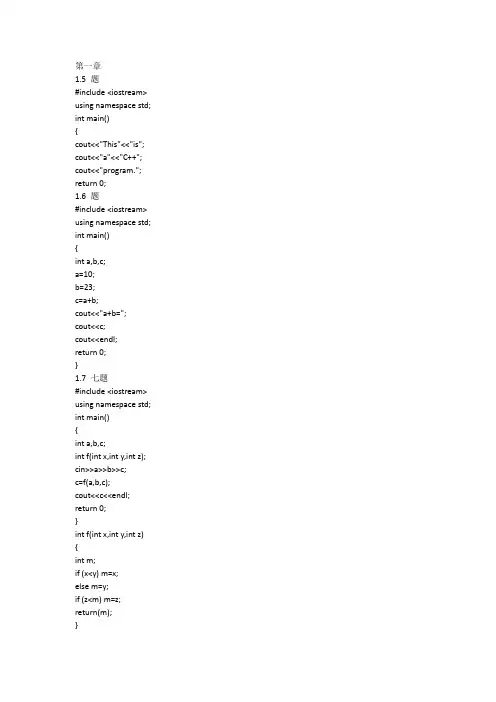
1.5 题#include <iostream> using namespace std; int main(){cout<<"This"<<"is"; cout<<"a"<<"C++"; cout<<"program."; return 0;1.6 题#include <iostream> using namespace std; int main(){int a,b,c;a=10;b=23;c=a+b;cout<<"a+b=";cout<<c;cout<<endl;return 0;}1.7 七题#include <iostream> using namespace std; int main(){int a,b,c;int f(int x,int y,int z); cin>>a>>b>>c;c=f(a,b,c);cout<<c<<endl; return 0;}int f(int x,int y,int z) {int m;if (x<y) m=x;else m=y;if (z<m) m=z;return(m);}#include <iostream>using namespace std;int main(){int a,b,c;cin>>a>>b;c=a+b;cout<<"a+b="<<a+b<<endl;return 0;}1.9 题#include <iostream>using namespace std;int main(){int a,b,c;int add(int x,int y);cin>>a>>b;c=add(a,b);cout<<"a+b="<<c<<endl;return 0;}int add(int x,int y){int z;z=x+y;return(z);}2.3 题#include <iostream>using namespace std;int main(){char c1='a',c2='b',c3='c',c4='\101',c5='\116';cout<<c1<<c2<<c3<<'\n';cout<<"\t\b"<<c4<<'\t'<<c5<<'\n';return 0;}2.4 题#include <iostream>using namespace std;int main(){char c1='C',c2='+',c3='+';cout<<"I say: \""<<c1<<c2<<c3<<'\"';cout<<"\t\t"<<"He says: \"C++ is very interesting!\""<<return 0;}2.7 题#include <iostream>using namespace std;int main(){int i,j,m,n;i=8;j=10;m=++i+j++;n=(++i)+(++j)+m;cout<<i<<'\t'<<j<<'\t'<<m<<'\t'<<n<<endl;return 0;}2.8 题#include <iostream>using namespace std;int main(){char c1='C', c2='h', c3='i', c4='n', c5='a';c1+=4;c2+=4;c3+=4;c4+=4;c5+=4;cout<<"password is:"<<c1<<c2<<c3<<c4<<c5<<endl; return 0;}3.2 题#include <iostream>#include <iomanip>using namespace std;int main ( ){float h,r,l,s,sq,vq,vz;const float pi=3.1415926;cout<<"please enter r,h:";cin>>r>>h;l=2*pi*r;s=r*r*pi;sq=4*pi*r*r;vq=3.0/4.0*pi*r*r*r;vz=pi*r*r*h;cout<<setiosflags(ios::fixed)<<setiosflags(ios::right) <<setprecision(2);cout<<"l= "<<setw(10)<<l<<endl;cout<<"s= "<<setw(10)<<s<<endl;cout<<"sq="<<setw(10)<<sq<<endl;cout<<"vq="<<setw(10)<<vq<<endl;cout<<"vz="<<setw(10)<<vz<<endl;return 0;}3.3 题#include <iostream>using namespace std;int main (){float c,f;cout<<"请输入一个华氏温度:";cin>>f;c=(5.0/9.0)*(f-32); //注意5 和9 要用实型表示,否则5/9 值为0cout<<"摄氏温度为:"<<c<<endl;return 0;};3.4 题#include <iostream>using namespace std;int main ( ){char c1,c2;cout<<"请输入两个字符c1,c2:";c1=getchar(); //将输入的第一个字符赋给c1c2=getchar(); //将输入的第二个字符赋给c2cout<<"用putchar 函数输出结果为:";putchar(c1);putchar(c2);cout<<endl;cout<<"用cout 语句输出结果为:";cout<<c1<<c2<<endl;return 0;}3.4 题另一解#include <iostream>using namespace std;int main ( ){char c1,c2;cout<<"请输入两个字符c1,c2:";c1=getchar(); //将输入的第一个字符赋给c1c2=getchar(); //将输入的第二个字符赋给c2cout<<"用putchar 函数输出结果为:";putchar(c1);putchar(44);putchar(c2);cout<<endl;cout<<"用cout 语句输出结果为:";cout<<c1<<","<<c2<<endl;return 0;}3.5 题#include <iostream>using namespace std;int main ( ){char c1,c2;int i1,i2; //定义为整型cout<<"请输入两个整数i1,i2:";cin>>i1>>i2;c1=i1;c2=i2;cout<<"按字符输出结果为:"<<c1<<" , "<<c2<<endl; return 0;}3.8 题#include <iostream>using namespace std;int main ( ){ int a=3,b=4,c=5,x,y;cout<<(a+b>c && b==c)<<endl;cout<<(a||b+c && b-c)<<endl;cout<<(!(a>b) && !c||1)<<endl;cout<<(!(x=a) && (y=b) && 0)<<endl;cout<<(!(a+b)+c-1 && b+c/2)<<endl;return 0;}3.9 题include <iostream>using namespace std;int main ( ){int a,b,c;cout<<"please enter three integer numbers:"; cin>>a>>b>>c;if(a<b)if(b<c)cout<<"max="<<c;elsecout<<"max="<<b;else if (a<c)cout<<"max="<<c;elsecout<<"max="<<a;cout<<endl;return 0;}3.9 题另一解#include <iostream>using namespace std;int main ( ){int a,b,c,temp,max ;cout<<"please enter three integer numbers:";cin>>a>>b>>c;temp=(a>b)?a:b; /* 将a 和b 中的大者存入temp 中*/max=(temp>c)?temp:c; /* 将a 和b 中的大者与c 比较,最大者存入max*/cout<<"max="<<max<<endl;return 0;}3.10 题#include <iostream>using namespace std;int main ( ){int x,y;cout<<"enter x:";cin>>x;if (x<1){y=x;cout<<"x="<<x<<", y=x="<<y;}else if (x<10) // 1≤x<10{y=2*x-1;cout<<"x="<<x<<", y=2*x-1="<<y;}else // x≥10{y=3*x-11;cout<<"x="<<x<<", y=3*x-11="<<y;}cout<<endl;return 0;}3.11 题#include <iostream>using namespace std;int main (){float score;char grade;cout<<"please enter score of student:";cin>>score;while (score>100||score<0){cout<<"data error,enter data again.";cin>>score;}switch(int(score/10)){case 10:case 9: grade='A';break;case 8: grade='B';break;case 7: grade='C';break;case 6: grade='D';break;default:grade='E';}cout<<"score is "<<score<<", grade is"<<grade<<endl;return 0;}3.12 题#include <iostream>using namespace std;int main (){long int num;int indiv,ten,hundred,thousand,ten_thousand,place; /* 分别代表个位, 十位,百位,千位,万位和位数*/cout<<"enter an integer(0~99999):";cin>>num;if (num>9999)place=5;else if (num>999)place=4;else if (num>99)place=3;else if (num>9)place=2;else place=1;cout<<"place="<<place<<endl;//计算各位数字ten_thousand=num/10000;thousand=(int)(num-ten_thousand*10000)/1000; hundred=(int)(num-ten_thousand*10000-thousand*1000)/ 100;ten=(int)(num-ten_thousand*10000-thousand*1000-hund red*100)/10;indiv=(int)(num-ten_thousand*10000-thousand*1000-hun dred*100-ten*10);cout<<"original order:";switch(place){case5:cout<<ten_thousand<<","<<thousand<<","<<hundred< <","<<ten<<","<<indiv<<endl;cout<<"reverse order:";cout<<indiv<<ten<<hundred<<thousand<<ten_thousand< <endl;break;case4:cout<<thousand<<","<<hundred<<","<<ten<<","<<indiv <<endl;cout<<"reverse order:";cout<<indiv<<ten<<hundred<<thousand<<endl;break;case3:cout<<hundred<<","<<ten<<","<<indiv<<endl;cout<<"reverse order:";cout<<indiv<<ten<<hundred<<endl;break;case 2:cout<<ten<<","<<indiv<<endl;cout<<"reverse order:";cout<<indiv<<ten<<endl;break;case 1:cout<<indiv<<endl;cout<<"reverse order:";cout<<indiv<<endl;break;}return 0;}3.13 题#include <iostream>using namespace std;int main (){ long i; //i 为利润float bonus,bon1,bon2,bon4,bon6,bon10;bon1=100000*0.1; //利润为10 万元时的奖金bon2=bon1+100000*0.075; //利润为20 万元时的奖金bon4=bon2+100000*0.05; //利润为40 万元时的奖金bon6=bon4+100000*0.03; //利润为60 万元时的奖金bon10=bon6+400000*0.015; //利润为100 万元时的奖金cout<<"enter i:";cin>>i;if (i<=100000)bonus=i*0.1; //利润在10 万元以内按10%提成奖金else if (i<=200000)bonus=bon1+(i-100000)*0.075; //利润在10 万元至20 万时的奖金else if (i<=400000)bonus=bon2+(i-200000)*0.05; //利润在20 万元至40 万时的奖金else if (i<=600000)bonus=bon4+(i-400000)*0.03; //利润在40 万元至60 万时的奖金else if (i<=1000000)bonus=bon6+(i-600000)*0.015; //利润在60 万元至100 万时的奖金elsebonus=bon10+(i-1000000)*0.01; //利润在100 万元以上时的奖金cout<<"bonus="<<bonus<<endl;return 0;}3.13 题另一解#include <iostream>using namespace std;int main (){long i;float bonus,bon1,bon2,bon4,bon6,bon10;int c;bon1=100000*0.1;bon2=bon1+100000*0.075;bon4=bon2+200000*0.05;bon6=bon4+200000*0.03;bon10=bon6+400000*0.015;cout<<"enter i:";cin>>i;c=i/100000;if (c>10) c=10;switch(c){case 0: bonus=i*0.1; break;case 1: bonus=bon1+(i-100000)*0.075; break; case 2:case 3: bonus=bon2+(i-200000)*0.05;break; case 4:case 5: bonus=bon4+(i-400000)*0.03;break; case 6:case 7:case 8:case 9: bonus=bon6+(i-600000)*0.015; break; case 10: bonus=bon10+(i-1000000)*0.01;}cout<<"bonus="<<bonus<<endl;return 0;}3.14 题#include <iostream>using namespace std;int main (){int t,a,b,c,d;cout<<"enter four numbers:";cin>>a>>b>>c>>d;cout<<"a="<<a<<", b="<<b<<",c="<<c<<",d="<<d<<endl;if (a>b){t=a;a=b;b=t;}if (a>c){t=a; a=c; c=t;}if (a>d){t=a; a=d; d=t;}if (b>c){t=b; b=c; c=t;}if (b>d){t=b; b=d; d=t;}if (c>d){t=c; c=d; d=t;}cout<<"the sorted sequence:"<<endl;cout<<a<<", "<<b<<", "<<c<<", "<<d<<endl;return 0;}3.15 题#include <iostream>using namespace std;int main (){int p,r,n,m,temp;cout<<"please enter two positive integer numbersn,m:";cin>>n>>m;if (n<m){temp=n;n=m;m=temp; //把大数放在n 中, 小数放在m 中}p=n*m; //先将n 和m 的乘积保存在p 中, 以便求最小公倍数时用while (m!=0) //求n 和m 的最大公约数{r=n%m;n=m;m=r;}cout<<"HCF="<<n<<endl;cout<<"LCD="<<p/n<<endl; // p 是原来两个整数的乘积return 0;}3.16 题#include <iostream>using namespace std;int main (){char c;int letters=0,space=0,digit=0,other=0;cout<<"enter one line::"<<endl;while((c=getchar())!='\n'){if (c>='a' && c<='z'||c>='A' && c<='Z')letters++;else if (c==' ')space++;else if (c>='0' && c<='9')digit++;elseother++;}cout<<"letter:"<<letters<<", space:"<<space<<", digit:"<<digit<<",other:"<<other<<endl;return 0;}3.17 题#include <iostream>using namespace std;int main (){int a,n,i=1,sn=0,tn=0;cout<<"a,n=:";cin>>a>>n;while (i<=n){tn=tn+a; //赋值后的tn 为i 个a 组成数的值sn=sn+tn; //赋值后的sn 为多项式前i 项之和a=a*10;++i;}cout<<"a+aa+aaa+...="<<sn<<endl;return 0;}3.18 题#include <iostream>using namespace std;int main (){float s=0,t=1;int n;for (n=1;n<=20;n++){t=t*n; // 求n!s=s+t; // 将各项累加}cout<<"1!+2!+...+20!="<<s<<endl;return 0;}3.19 题#include <iostream>using namespace std;int main (){int i,j,k,n;cout<<"narcissus numbers are:"<<endl;for (n=100;n<1000;n++){i=n/100;j=n/10-i*10;k=n%10;if (n == i*i*i + j*j*j + k*k*k)cout<<n<<" ";}cout<<endl;return 0;}3.20 题#include <iostream>using namespace std;int main(){const int m=1000; // 定义寻找范围int k1,k2,k3,k4,k5,k6,k7,k8,k9,k10;int i,a,n,s;for (a=2;a<=m;a++) // a 是2~1000 之间的整数,检查它是否为完数{n=0; // n 用来累计a 的因子的个数s=a; // s 用来存放尚未求出的因子之和,开始时等于afor (i=1;i<a;i++) // 检查i 是否为a 的因子if (a%i==0) // 如果i 是a 的因子{n++; // n 加1,表示新找到一个因子s=s-i; // s 减去已找到的因子,s 的新值是尚未求出的因子之和switch(n) // 将找到的因子赋给k1,...,k10 {case 1:k1=i; break; // 找出的笫1 个因子赋给k1case 2:k2=i; break; // 找出的笫2 个因子赋给k2case 3:k3=i; break; // 找出的笫3 个因子赋给k3case 4:k4=i; break; // 找出的笫4 个因子赋给k4case 5:k5=i; break; // 找出的笫5 个因子赋给k5case 6:k6=i; break; // 找出的笫6 个因子赋给k6case 7:k7=i; break; // 找出的笫7 个因子赋给k7 case 8:k8=i; break; // 找出的笫8 个因子赋给k8 case 9:k9=i; break; // 找出的笫9 个因子赋给k9 case 10:k10=i; break; // 找出的笫10 个因子赋给k10 }}if (s==0) // s=0 表示全部因子都已找到了{cout<<a<<" is a 完数"<<endl;cout<<"its factors are:";if (n>1) cout<<k1<<","<<k2; // n>1 表示a 至少有2 个因子if (n>2) cout<<","<<k3; // n>2 表示至少有3 个因子,故应再输出一个因子if (n>3) cout<<","<<k4; // n>3 表示至少有4 个因子,故应再输出一个因子if (n>4) cout<<","<<k5; // 以下类似if (n>5) cout<<","<<k6;if (n>6) cout<<","<<k7;if (n>7) cout<<","<<k8;if (n>8) cout<<","<<k9;if (n>9) cout<<","<<k10;cout<<endl<<endl;}}return 0;}3.20 题另一解#include <iostream>using namespace std;int main(){int m,s,i;for (m=2;m<1000;m++){s=0;for (i=1;i<m;i++)if ((m%i)==0) s=s+i;if(s==m){cout<<m<<" is a 完数"<<endl;cout<<"its factors are:";for (i=1;i<m;i++)if (m%i==0) cout<<i<<" ";cout<<endl;}return 0;}3.20 题另一解#include <iostream>using namespace std;int main(){int k[11];int i,a,n,s;for (a=2;a<=1000;a++){n=0;s=a;for (i=1;i<a;i++)if ((a%i)==0){n++;s=s-i;k[n]=i; // 将找到的因子赋给k[1]┅k[10]}if (s==0){cout<<a<<" is a 完数"<<endl;cout<<"its factors are:";for (i=1;i<n;i++)cout<<k[i]<<" ";cout<<k[n]<<endl;}}return 0;}3.21 题#include <iostream>using namespace std;int main(){int i,t,n=20;double a=2,b=1,s=0;for (i=1;i<=n;i++){s=s+a/b;t=a;a=a+b; // 将前一项分子与分母之和作为下一项的分子b=t; // 将前一项的分子作为下一项的分母}cout<<"sum="<<s<<endl;return 0;3.22 题#include <iostream>using namespace std;int main(){int day,x1,x2;day=9;x2=1;while(day>0){x1=(x2+1)*2; // 第1 天的桃子数是第2 天桃子数加1 后的2 倍x2=x1;day--;}cout<<"total="<<x1<<endl;return 0;}3.23 题#include <iostream>#include <cmath>using namespace std;int main(){float a,x0,x1;cout<<"enter a positive number:";cin>>a; // 输入a 的值x0=a/2;x1=(x0+a/x0)/2;do{x0=x1;x1=(x0+a/x0)/2;}while(fabs(x0-x1)>=1e-5);cout<<"The square root of "<<a<<" is "<<x1<<endl;return 0;}3.24 题#include <iostream>using namespace std;int main(){int i,k;for (i=0;i<=3;i++) // 输出上面4 行*号{for (k=0;k<=2*i;k++)cout<<"*"; // 输出*号cout<<endl; //输出完一行*号后换行for (i=0;i<=2;i++) // 输出下面3 行*号{for (k=0;k<=4-2*i;k++)cout<<"*"; // 输出*号cout<<endl; // 输出完一行*号后换行}return 0;}3.25 题#include <iostream>using namespace std;int main(){char i,j,k; /* i 是a 的对手;j 是b 的对手;k 是c 的对手*/for (i='X';i<='Z';i++)for (j='X';j<='Z';j++)if (i!=j)for (k='X';k<='Z';k++)if (i!=k && j!=k)if (i!='X' && k!='X' && k!='Z')cout<<"A--"<<i<<" B--"<<j<<"C--"<<k<<endl;return 0;}4.1 题#include <iostream>using namespace std;int main(){int hcf(int,int);int lcd(int,int,int);int u,v,h,l;cin>>u>>v;h=hcf(u,v);cout<<"H.C.F="<<h<<endl;l=lcd(u,v,h);cout<<"L.C.D="<<l<<endl;return 0;}int hcf(int u,int v){int t,r;if (v>u){t=u;u=v;v=t;}while ((r=u%v)!=0){u=v;v=r;}return(v);}int lcd(int u,int v,int h){return(u*v/h);}4.2 题#include <iostream>#include <math.h>using namespace std;float x1,x2,disc,p,q;int main(){void greater_than_zero(float,float);void equal_to_zero(float,float);void smaller_than_zero(float,float);float a,b,c;cout<<"input a,b,c:";cin>>a>>b>>c;disc=b*b-4*a*c;cout<<"root:"<<endl;if (disc>0){greater_than_zero(a,b);cout<<"x1="<<x1<<",x2="<<x2<<endl;}else if (disc==0){equal_to_zero(a,b);cout<<"x1="<<x1<<",x2="<<x2<<endl;}else{smaller_than_zero(a,b);cout<<"x1="<<p<<"+"<<q<<"i"<<endl;cout<<"x2="<<p<<"-"<<q<<"i"<<endl;}return 0;}void greater_than_zero(float a,float b) /* 定义一个函数,用来求disc>0 时方程的根*/{x1=(-b+sqrt(disc))/(2*a);x2=(-b-sqrt(disc))/(2*a);}void equal_to_zero(float a,float b) /* 定义一个函数,用来求disc=0 时方程{x1=x2=(-b)/(2*a);}void smaller_than_zero(float a,float b) /* 定义一个函数,用来求disc<0 时方程的根*/{p=-b/(2*a);q=sqrt(-disc)/(2*a);}4.3 题#include <iostream>using namespace std;int main(){int prime(int); /* 函数原型声明*/int n;cout<<"input an integer:";cin>>n;if (prime(n))cout<<n<<" is a prime."<<endl;elsecout<<n<<" is not a prime."<<endl;return 0;}int prime(int n){int flag=1,i;for (i=2;i<n/2 && flag==1;i++)if (n%i==0)flag=0;return(flag);}4.4 题#include <iostream>using namespace std;int main(){int fac(int);int a,b,c,sum=0;cout<<"enter a,b,c:";cin>>a>>b>>c;sum=sum+fac(a)+fac(b)+fac(c);cout<<a<<"!+"<<b<<"!+"<<c<<"!="<<sum<<endl;return 0;}{int f=1;for (int i=1;i<=n;i++)f=f*i;return f;}4.5 题#include <iostream>#include <cmath>using namespace std;int main(){double e(double);double x,sinh;cout<<"enter x:";cin>>x;sinh=(e(x)+e(-x))/2;cout<<"sinh("<<x<<")="<<sinh<<endl;return 0;}double e(double x){return exp(x);}4.6 题#include <iostream>#include <cmath>using namespace std;int main(){double solut(double ,double ,double ,double ); double a,b,c,d;cout<<"input a,b,c,d:";cin>>a>>b>>c>>d;cout<<"x="<<solut(a,b,c,d)<<endl;return 0;}double solut(double a,double b,double c,double d) {double x=1,x0,f,f1;do{x0=x;f=((a*x0+b)*x0+c)*x0+d;f1=(3*a*x0+2*b)*x0+c;x=x0-f/f1;}while(fabs(x-x0)>=1e-5);return(x);}4.7 题#include <iostream>#include <cmath>using namespace std;int main(){void godbaha(int);int n;cout<<"input n:";cin>>n;godbaha(n);return 0;}void godbaha(int n){int prime(int);int a,b;for(a=3;a<=n/2;a=a+2){if(prime(a)){b=n-a;if (prime(b))cout<<n<<"="<<a<<"+"<<b<<endl;} }}int prime(int m){int i,k=sqrt(m);for(i=2;i<=k;i++)if(m%i==0) break;if (i>k) return 1;else return 0;}4.8 题#include <iostream>using namespace std;int main(){int x,n;float p(int,int);cout<<"input n & x:";cin>>n>>x;cout<<"n="<<n<<",x="<<x<<endl;; cout<<"P"<<n<<"(x)="<<p(n,x)<<endl; return 0;}float p(int n,int x){if (n==0)return(1);return(x);elsereturn(((2*n-1)*x*p((n-1),x)-(n-1)*p((n-2),x))/n);}4.9 题#include <iostream>using namespace std;int main(){void hanoi(int n,char one,char two,char three);int m;cout<<"input the number of diskes:";cin>>m;cout<<"The steps of moving "<<m<<" disks:"<<endl; hanoi(m,'A','B','C');return 0;}void hanoi(int n,char one,char two,char three)//将n 个盘从one 座借助two 座,移到three 座{void move(char x,char y);if(n==1) move(one,three);else{hanoi(n-1,one,three,two);move(one,three);hanoi(n-1,two,one,three);}}void move(char x,char y){cout<<x<<"-->"<<y<<endl;}4.10 题#include <iostream>using namespace std;int main(){void convert(int n);int number;cout<<"input an integer:";cin>>number;cout<<"output:"<<endl;if (number<0){cout<<"-";number=-number;}convert(number);cout<<endl;}void convert(int n){int i;char c;if ((i=n/10)!=0)convert(i);c=n%10+'0';cout<<" "<<c;}4.11 题#include <iostream>using namespace std;int main(){int f(int);int n,s;cout<<"input the number n:";cin>>n;s=f(n);cout<<"The result is "<<s<<endl;return 0;}int f(int n){;if (n==1)return 1;elsereturn (n*n+f(n-1));}4.12 题#include <iostream>#include <cmath>using namespace std;#define S(a,b,c) (a+b+c)/2#define AREA(a,b,c)sqrt(S(a,b,c)*(S(a,b,c)-a)*(S(a,b,c)-b)*(S(a,b,c)-c)) int main(){float a,b,c;cout<<"input a,b,c:";cin>>a>>b>>c;if (a+b>c && a+c>b && b+c>a)cout<<"area="<<AREA(a,b,c)<<endl;elsecout<<"It is not a triangle!"<<endl;}4.14 题#include <iostream>using namespace std;//#define LETTER 1int main(){char c;cin>>c;#if LETTERif(c>='a' && c<='z')c=c-32;#elseif(c>='A' && c<='Z')c=c+32;#endifcout<<c<<endl;return 0;}4.15 题#include <iostream>using namespace std;#define CHANGE 1int main(){char ch[40];cout<<"input text:"<<endl;;gets(ch);#if (CHANGE){for (int i=0;i<40;i++){if (ch[i]!='\0')if (ch[i]>='a'&& ch[i]<'z'||ch[i]>'A'&& ch[i]<'Z') ch[i]+=1;else if (ch[i]=='z'||ch[i]=='Z')ch[i]-=25;}}#endifcout<<"output:"<<endl<<ch<<endl;return 0;}4.16 题file#include <iostream>using namespace std;int a;{extern int power(int);int b=3,c,d,m;cout<<"enter an integer a and its power m:"<<endl; cin>>a>>m;c=a*b;cout<<a<<"*"<<b<<"="<<c<<endl;d=power(m);cout<<a<<"**"<<m<<"="<<d<<endl;return 0;}4.16 题fileextern int a;int power(int n){int i,y=1;for(i=1;i<=n;i++)y*=a;return y;}5.1 题#include <iostream>#include <iomanip>using namespace std;#include <math.h>int main(){int i,j,n,a[101];for (i=1;i<=100;i++)a[i]=i;a[1]=0;for (i=2;i<sqrt(100);i++)for (j=i+1;j<=100;j++){if(a[i]!=0 && a[j]!=0)if (a[j]%a[i]==0)a[j]=0; }cout<<endl;for (i=1,n=0;i<=100;i++){if (a[i]!=0){cout<<setw(5)<<a[i]<<" ";n++;}if(n==10){cout<<endl;n=0;}}cout<<endl;}5.2 题#include <iostream>using namespace std;//#include <math.h>int main(){int i,j,min,temp,a[11];cout<<"enter data:"<<endl;for (i=1;i<=10;i++){cout<<"a["<<i<<"]=";cin>>a[i]; //输入10 个数}cout<<endl<<"The original numbers:"<<endl;;for (i=1;i<=10;i++)cout<<a[i]<<" "; // 输出这10 个数cout<<endl;;for (i=1;i<=9;i++) //以下8 行是对10 个数排序{min=i;for (j=i+1;j<=10;j++)if (a[min]>a[j]) min=j;temp=a[i]; //以下3 行将a[i+1]~a[10]中最小者与a[i] 对换a[i]=a[min];a[min]=temp;}cout<<endl<<"The sorted numbers:"<<endl;for (i=1;i<=10;i++) // 输出已排好序的10 个数cout<<a[i]<<" ";cout<<endl;return 0;}5.3 题#include <iostream>using namespace std;int main(){int a[3][3],sum=0;int i,j;cout<<"enter data:"<<endl;;for (i=0;i<3;i++)for (j=0;j<3;j++)cin>>a[i][j];for (i=0;i<3;i++)sum=sum+a[i][i];。
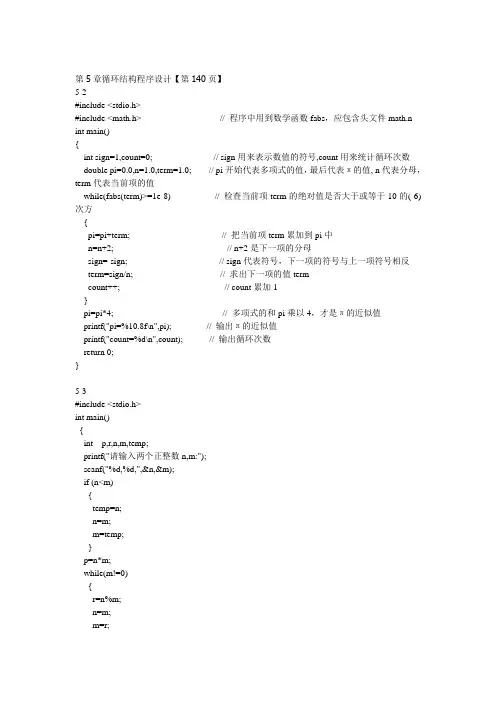
第5章循环结构程序设计【第140页】5-2#include <stdio.h>#include <math.h> // 程序中用到数学函数fabs,应包含头文件math.n int main(){int sign=1,count=0; // sign用来表示数值的符号,count用来统计循环次数double pi=0.0,n=1.0,term=1.0; // pi开始代表多项式的值,最后代表π的值, n代表分母,term代表当前项的值while(fabs(term)>=1e-8) // 检查当前项term的绝对值是否大于或等于10的(-6)次方{pi=pi+term; // 把当前项term累加到pi中n=n+2; // n+2是下一项的分母sign=-sign; // sign代表符号,下一项的符号与上一项符号相反term=sign/n; // 求出下一项的值termcount++; // count累加1}pi=pi*4; // 多项式的和pi乘以4,才是π的近似值printf("pi=%10.8f\n",pi); // 输出π的近似值printf("count=%d\n",count); // 输出循环次数return 0;}5-3#include <stdio.h>int main(){int p,r,n,m,temp;printf("请输入两个正整数n,m:");scanf("%d,%d,",&n,&m);if (n<m){temp=n;n=m;m=temp;}p=n*m;while(m!=0){r=n%m;n=m;m=r;printf("它们的最大公约数为:%d\n",n);printf("它们的最小公约数为:%d\n",p/n);return 0;}5-4#include <stdio.h>int main(){char c;int letters=0,space=0,digit=0,other=0;printf("请输入一行字符:\n");while((c=getchar())!='\n'){if (c>='a' && c<='z' || c>='A' && c<='Z')letters++;else if (c==' ')space++;else if (c>='0' && c<='9')digit++;elseother++;}printf("字母数:%d\n空格数:%d\n数字数:%d\n其它字符数:%d\n",letters,space,digit,other);return 0;}5-5#include <stdio.h>int main(){int a,n,i=1,sn=0,tn=0;printf("a,n=:");scanf("%d,%d",&a,&n);while (i<=n){tn=tn+a; /*赋值后的tn为i个a组成数的值*/sn=sn+tn; /*赋值后的sn为多项式前i项之和*/a=a*10;++i;}printf("a+aa+aaa+...=%d\n",sn);return 0;5-6#include <stdio.h>int main(){double s=0,t=1;int n;for (n=1;n<=20;n++){t=t*n;s=s+t;}printf("1!+2!+...+20!=%22.15e\n",s);return 0;}5-7#include <stdio.h>int main(){int n1=100,n2=50,n3=10;double k,s1=0,s2=0,s3=0;for (k=1;k<=n1;k++) /*计算1到100的和*/{s1=s1+k;}for (k=1;k<=n2;k++) /*计算1到50各数的平方和*/ {s2=s2+k*k;}for (k=1;k<=n3;k++) /*计算1到10的各倒数和*/{s3=s3+1/k;}printf("sum=%15.6f\n",s1+s2+s3);return 0;}5-8#include <stdio.h>int main(){int i,j,k,n;printf("parcissus numbers are ");for (n=100;n<1000;n++){i=n/100;j=n/10-i*10;k=n%10;if (n==i*i*i + j*j*j + k*k*k)printf("%d ",n);}printf("\n");return 0;}5-9-1#define M 1000 /*定义寻找范围*/#include <stdio.h>int main(){int k1,k2,k3,k4,k5,k6,k7,k8,k9,k10;int i,a,n,s;for (a=2;a<=M;a++) /* a是2-1000之间的整数,检查它是否完数*/{n=0; /* n用来累计a的因子的个数*/s=a; /* s用来存放尚未求出的因子之和,开始时等于a */for (i=1;i<a;i++) /* 检查i是否a的因子*/if (a%i==0) /* 如果i是a的因子*/{n++; /* n加1,表示新找到一个因子*/s=s-i; /* s减去已找到的因子,s的新值是尚未求出的因子之和*/ switch(n) /* 将找到的因子赋给k1...k9,或k10 */{case 1:k1=i; break; /* 找出的笫1个因子赋给k1 */case 2:k2=i; break; /* 找出的笫2个因子赋给k2 */case 3:k3=i; break; /* 找出的笫3个因子赋给k3 */case 4:k4=i; break; /* 找出的笫4个因子赋给k4 */case 5:k5=i; break; /* 找出的笫5个因子赋给k5 */case 6:k6=i; break; /* 找出的笫6个因子赋给k6 */case 7:k7=i; break; /* 找出的笫7个因子赋给k7 */case 8:k8=i; break; /* 找出的笫8个因子赋给k8 */case 9:k9=i; break; /*找出的笫9个因子赋给k9 */case 10:k10=i; break; /* 找出的笫10个因子赋给k10 */}}if (s==0){printf("%d ,Its factors are ",a);if (n>1) printf("%d,%d",k1,k2); /* n>1表示a至少有2个因子*/if (n>2) printf(",%d",k3); /* n>2表示至少有3个因子,故应再输出一个因子*/if (n>3) printf(",%d",k4); /* n>3表示至少有4个因子,故应再输出一个因子*/if (n>4) printf(",%d",k5); /* 以下类似*/if (n>5) printf(",%d",k6);if (n>6) printf(",%d",k7);if (n>7) printf(",%d",k8);if (n>8) printf(",%d",k9);if (n>9) printf(",%d",k10);printf("\n");}}return 0;}5-9-2#include <stdio.h>int main(){int m,s,i;for (m=2;m<1000;m++){s=0;for (i=1;i<m;i++)if ((m%i)==0) s=s+i;if(s==m){printf("%d,its factors are ",m);for (i=1;i<m;i++)if (m%i==0) printf("%d ",i);printf("\n");}}return 0;}5-10#include <stdio.h>int main(){int i,n=20;double a=2,b=1,s=0,t;for (i=1;i<=n;i++){s=s+a/b;t=a,a=a+b,b=t;}printf("sum=%16.10f\n",s);return 0;}5-11#include <stdio.h>int main(){double sn=100,hn=sn/2;int n;for (n=2;n<=10;n++){sn=sn+2*hn; /*第n次落地时共经过的米数*/hn=hn/2; /*第n次反跳高度*/}printf("第10次落地时共经过%f米\n",sn);printf("第10次反弹%f米\n",hn);return 0;}5-12#include <stdio.h>int main(){int day,x1,x2;day=9;x2=1;while(day>0){x1=(x2+1)*2; /*第1天的桃子数是第2天桃子数加1后的2倍.*/ x2=x1;day--;}printf("total=%d\n",x1);return 0;}5-13#include <stdio.h>#include <math.h>int main(){float a,x0,x1;printf("enter a positive number:");scanf("%f",&a);x0=a/2;x1=(x0+a/x0)/2;do{x0=x1;x1=(x0+a/x0)/2;}while(fabs(x0-x1)>=1e-5);printf("The square root of %5.2f is %8.5f\n",a,x1); return 0;}5-14#include <stdio.h>#include <math.h>int main(){double x1,x0,f,f1;x1=1.5;do{x0=x1;f=((2*x0-4)*x0+3)*x0-6;f1=(6*x0-8)*x0+3;x1=x0-f/f1;}while(fabs(x1-x0)>=1e-5);printf("The root of equation is %5.2f\n",x1);return 0;}5-15#include <stdio.h>#include <math.h>int main(){float x0,x1,x2,fx0,fx1,fx2;do{printf("enter x1 & x2:");scanf("%f,%f",&x1,&x2);fx1=x1*((2*x1-4)*x1+3)-6;fx2=x2*((2*x2-4)*x2+3)-6;}while(fx1*fx2>0);do{x0=(x1+x2)/2;fx0=x0*((2*x0-4)*x0+3)-6;if ((fx0*fx1)<0){x2=x0;fx2=fx0;}else{x1=x0;fx1=fx0;}}while(fabs (fx0)>=1e-5); printf("x=%6.2f\n",x0); return 0;}5-16#include <stdio.h>int main(){int i,j,k;for (i=0;i<=3;i++){for (j=0;j<=2-i;j++)printf(" ");for (k=0;k<=2*i;k++)printf("*");printf("\n");}for (i=0;i<=2;i++){for (j=0;j<=i;j++)printf(" ");for (k=0;k<=4-2*i;k++)printf("*");printf("\n");}return 0;}5-17#include <stdio.h>int main(){char i,j,k; /*是a的对手;j是b的对手;k是c的对手*/ for (i='x';i<='z';i++)for (j='x';j<='z';j++)if (i!=j)for (k='x';k<='z';k++)if (i!=k && j!=k)if (i!='x' && k!='x' && k!='z')printf("A--%c\nB--%c\nC--%c\n",i,j,k);return 0;}第6章利用数组处理批量数据【第168页】6-1#include <stdio.h>#include <math.h>int main(){int i,j,n,a[101];for (i=1;i<=100;i++)a[i]=i;a[1]=0;for (i=2;i<sqrt(100);i++)for (j=i+1;j<=100;j++){if(a[i]!=0 && a[j]!=0)if (a[j]%a[i]==0)a[j]=0;}printf("\n");for (i=2,n=0;i<=100;i++){ if(a[i]!=0){printf("%5d",a[i]);n++;}if(n==10){printf("\n");n=0;}}printf("\n");return 0;}6-2#include <stdio.h>int main(){int i,j,min,temp,a[11];printf("enter data:\n");for (i=1;i<=10;i++){printf("a[%d]=",i);scanf("%d",&a[i]);}printf("\n");printf("The orginal numbers:\n"); for (i=1;i<=10;i++)printf("%5d",a[i]);printf("\n");for (i=1;i<=9;i++){min=i;for (j=i+1;j<=10;j++)if (a[min]>a[j]) min=j;temp=a[i];a[i]=a[min];a[min]=temp;}printf("\nThe sorted numbers:\n"); for (i=1;i<=10;i++)printf("%5d",a[i]);printf("\n");return 0;}6-3#include <stdio.h>int main(){int a[3][3],sum=0;int i,j;printf("enter data:\n");for (i=0;i<3;i++)for (j=0;j<3;j++)scanf("%3d",&a[i][j]);for (i=0;i<3;i++)sum=sum+a[i][i];printf("sum=%6d\n",sum);return 0;}6-4#include <stdio.h>int main(){ int a[11]={1,4,6,9,13,16,19,28,40,100}; int temp1,temp2,number,end,i,j;printf("array a:\n");for (i=0;i<10;i++)printf("%5d",a[i]);printf("\n");printf("insert data:");scanf("%d",&number);end=a[9];if (number>end)a[10]=number;else{for (i=0;i<10;i++){if (a[i]>number){temp1=a[i];a[i]=number;for (j=i+1;j<11;j++){temp2=a[j];a[j]=temp1;temp1=temp2;}break;}}}printf("Now array a:\n");for (i=0;i<11;i++)printf("%5d",a[i]);printf("\n");return 0;}6-5#include <stdio.h>#define N 5int main(){ int a[N],i,temp;printf("enter array a:\n");for (i=0;i<N;i++)scanf("%d",&a[i]);printf("array a:\n");for (i=0;i<N;i++)printf("%4d",a[i]);for (i=0;i<N/2;i++) //循环的作用是将对称的元素的值互换{ temp=a[i];a[i]=a[N-i-1];a[N-i-1]=temp;}printf("\nNow,array a:\n");for (i=0;i<N;i++)printf("%4d",a[i]);printf("\n");return 0;}6-6#include <stdio.h>#define N 10int main(){ int i,j,a[N][N];for (i=0;i<N;i++){a[i][i]=1;a[i][0]=1;}for (i=2;i<N;i++)for (j=1;j<=i-1;j++)a[i][j]=a[i-1][j-1]+a[i-1][j];for (i=0;i<N;i++){for (j=0;j<=i;j++)printf("%6d",a[i][j]);printf("\n");}printf("\n");return 0;}6-7#include <stdio.h>int main(){ int a[15][15],i,j,k,p,n;p=1;while(p==1){printf("enter n(n=1--15):");scanf("%d",&n);if ((n!=0) && (n<=15) && (n%2!=0))p=0;}for (i=1;i<=n;i++)for (j=1;j<=n;j++)a[i][j]=0;j=n/2+1;a[1][j]=1;for (k=2;k<=n*n;k++){i=i-1;j=j+1;if ((i<1) && (j>n)){i=i+2;j=j-1;}else{if (i<1) i=n;if (j>n) j=1;}if (a[i][j]==0)a[i][j]=k;else{i=i+2;j=j-1;a[i][j]=k;}}for (i=1;i<=n;i++){for (j=1;j<=n;j++)printf("%5d",a[i][j]);printf("\n");}return 0;}#include <stdio.h>#define N 4#define M 5 /* 数组为4行5列*/int main(){int i,j,k,a[N][M],max,maxj,flag;printf("please input matrix:\n");for (i=0;i<N;i++) /* 输入数组*/for (j=0;j<M;j++)scanf("%d",&a[i][j]);for (i=0;i<N;i++){max=a[i][0]; /* 开始时假设a[i][0]最大*/maxj=0; /* 将列号0赋给maxj保存*/for (j=0;j<M;j++) /* 找出第i行中的最大数*/if (a[i][j]>max){max=a[i][j]; /* 将本行的最大数存放在max中*/maxj=j; /* 将最大数所在的列号存放在maxj中*/}flag=1; /* 先假设是鞍点,以flag为1代表*/for (k=0;k<N;k++)if (max>a[k][maxj]) /* 将最大数和其同列元素相比*/{flag=0; /* 如果max不是同列最小,表示不是鞍点令flag1为0 */continue;}if(flag) /* 如果flag1为1表示是鞍点*/{printf("a[%d][%d]=%d\n",i,maxj,max); /* 输出鞍点的值和所在行列号*/break;}}if(!flag) /* 如果flag为0表示鞍点不存在*/printf("It is not exist!\n");return 0;}6-9#include <stdio.h>#define N 15int main(){ int i,number,top,bott,mid,loca,a[N],flag=1,sign;char c;printf("enter data:\n");scanf("%d",&a[0]);while(i<N){scanf("%d",&a[i]);if (a[i]>=a[i-1])i++;elseprintf("enter this data again:\n");}printf("\n");for (i=0;i<N;i++)printf("%5d",a[i]);printf("\n");while(flag){printf("input number to look for:");scanf("%d",&number);sign=0;top=0; //top是查找区间的起始位置bott=N-1; //bott是查找区间的最末位置if ((number<a[0])||(number>a[N-1])) //要查的数不在查找区间内loca=-1; // 表示找不到while ((!sign) && (top<=bott)){mid=(bott+top)/2;if (number==a[mid]){loca=mid;printf("Has found %d, its position is %d\n",number,loca+1);sign=1;}else if (number<a[mid])bott=mid-1;elsetop=mid+1;}if(!sign||loca==-1)printf("cannot find %d.\n",number);;printf("continu or not(Y/N)?");scanf(" %c",&c);if (c=='N'||c=='n')flag=0;}return 0;}6-10#include <stdio.h>int main(){int i,j,upp,low,dig,spa,oth;char text[3][80];upp=low=dig=spa=oth=0;for (i=0;i<3;i++){ printf("please input line %d:\n",i+1);gets(text[i]);for (j=0;j<80 && text[i][j]!='\0';j++){if (text[i][j]>='A'&& text[i][j]<='Z')upp++;else if (text[i][j]>='a' && text[i][j]<='z')low++;else if (text[i][j]>='0' && text[i][j]<='9')dig++;else if (text[i][j]==' ')spa++;elseoth++;}}printf("\nupper case: %d\n",upp);printf("lower case: %d\n",low);printf("digit : %d\n",dig);printf("space : %d\n",spa);printf("other : %d\n",oth);return 0;}6-11#include <stdio.h>int main(){ char a[5]={'*','*','*','*','*'};int i,j,k;char space=' ';for (i=0;i<5;i++){ printf("\n");printf(" ");for (j=1;j<=i;j++)printf("%c",space);for (k=0;k<5;k++)printf("%c",a[k]);}printf("\n");return 0;}6-12a-c#include <stdio.h>int main(){ int j,n;char ch[80],tran[80];printf("input cipher code:");gets(ch);printf("\ncipher code :%s",ch);j=0;while (ch[j]!='\0'){ if ((ch[j]>='A') && (ch[j]<='Z'))tran[j]=155-ch[j];else if ((ch[j]>='a') && (ch[j]<='z'))tran[j]=219-ch[j];elsetran[j]=ch[j];j++;}n=j;printf("\noriginal text:");for (j=0;j<n;j++)putchar(tran[j]);printf("\n");return 0;}6-12b#include <stdio.h>int main(){int j,n;char ch[80];printf("input cipher code:\n");gets(ch);printf("\ncipher code:%s\n",ch);j=0;while (ch[j]!='\0'){ if ((ch[j]>='A') && (ch[j]<='Z'))ch[j]=155-ch[j];else if ((ch[j]>='a') && (ch[j]<='z'))ch[j]=219-ch[j];elsech[j]=ch[j];j++;}n=j;printf("original text:");for (j=0;j<n;j++)putchar(ch[j]);printf("\n");return 0;}6-13#include <stdio.h>int main(){ char s1[80],s2[40];int i=0,j=0;printf("input string1:");scanf("%s",s1);printf("input string2:");scanf("%s",s2);while (s1[i]!='\0')i++;while(s2[j]!='\0')s1[i++]=s2[j++];s1[i]='\0';printf("\nThe new string is:%s\n",s1); return 0;}6-14#include <stdio.h>int main(){ int i,resu;char s1[100],s2[100];printf("input string1:");gets(s1);printf("\ninput string2:");gets(s2);i=0;while ((s1[i]==s2[i]) && (s1[i]!='\0'))i++;if (s1[i]=='\0' && s2[i]=='\0')resu=0;elseresu=s1[i]-s2[i];printf("\nresult:%d.\n",resu);return 0;}6-15#include <stdio.h>#include <string.h>int main(){ char s1[80],s2[80];int i;printf("input s2:");scanf("%s",s2);for (i=0;i<=strlen(s2);i++)s1[i]=s2[i];printf("s1:%s\n",s1);return 0;}第7章用函数实现模块化程序设计【第218页】7-1-1#include <stdio.h>int main(){int hcf(int,int);int lcd(int,int,int);int u,v,h,l;scanf("%d,%d",&u,&v);h=hcf(u,v);printf("H.C.F=%d\n",h);l=lcd(u,v,h);printf("L.C.D=%d\n",l);return 0;}int hcf(int u,int v){int t,r;if (v>u){t=u;u=v;v=t;}while ((r=u%v)!=0){u=v;v=r;}return(v);}int lcd(int u,int v,int h){return(u*v/h);}7-1-2#include <stdio.h>int Hcf,Lcd;int main(){void hcf(int,int);void lcd(int,int);int u,v;scanf("%d,%d",&u,&v); hcf(u,v);lcd(u,v);printf("H.C.F=%d\n",Hcf); printf("L.C.D=%d\n",Lcd); return 0;}void hcf(int u,int v){int t,r;if (v>u){t=u;u=v;v=t;}while ((r=u%v)!=0){u=v;v=r;}Hcf=v;}void lcd(int u,int v){Lcd=u*v/Hcf;}7-2#include <stdio.h>#include <math.h>float x1,x2,disc,p,q;int main(){void greater_than_zero(float,float);void equal_to_zero(float,float);void smaller_than_zero(float,float);float a,b,c;printf("input a,b,c:");scanf("%f,%f,%f",&a,&b,&c);printf("equation: %5.2f*x*x+%5.2f*x+%5.2f=0\n",a,b,c); disc=b*b-4*a*c;printf("root:\n");if (disc>0){greater_than_zero(a,b);printf("x1=%f\t\tx2=%f\n",x1,x2);}else if (disc==0){equal_to_zero(a,b);printf("x1=%f\t\tx2=%f\n",x1,x2);}else{smaller_than_zero(a,b);printf("x1=%f+%fi\tx2=%f-%fi\n",p,q,p,q);}return 0;}void greater_than_zero(float a,float b){x1=(-b+sqrt(disc))/(2*a);x2=(-b-sqrt(disc))/(2*a);}void equal_to_zero(float a,float b){x1=x2=(-b)/(2*a);}void smaller_than_zero(float a,float b){p=-b/(2*a);q=sqrt(-disc)/(2*a);}7-3#include <stdio.h>int main(){int prime(int);int n;printf("input an integer:");scanf("%d",&n);if (prime(n))printf("%d is a prime.\n",n); elseprintf("%d is not a prime.\n",n); return 0;}int prime(int n){int flag=1,i;for (i=2;i<n/2 && flag==1;i++)if (n%i==0)flag=0;return(flag);}7-4#include <stdio.h>#define N 3int array[N][N];int main(){ void convert(int array[][3]);int i,j;printf("input array:\n");for (i=0;i<N;i++)for (j=0;j<N;j++)scanf("%d",&array[i][j]); printf("\noriginal array :\n");for (i=0;i<N;i++){for (j=0;j<N;j++)printf("%5d",array[i][j]);printf("\n");}convert(array);printf("convert array:\n");for (i=0;i<N;i++){for (j=0;j<N;j++)printf("%5d",array[i][j]);printf("\n");}return 0;}void convert(int array[][3]){int i,j,t;for (i=0;i<N;i++)for (j=i+1;j<N;j++){t=array[i][j];array[i][j]=array[j][i];array[j][i]=t;}}#include <stdio.h>#include <string.h>int main(){void inverse(char str[]);char str[100];printf("input string:");scanf("%s",str);inverse(str);printf("inverse string:%s\n",str);return 0;}void inverse(char str[]){char t;int i,j;for (i=0,j=strlen(str);i<(strlen(str)/2);i++,j--) {t=str[i];str[i]=str[j-1];str[j-1]=t;}}7-6#include <stdio.h>int main(){void concatenate(char string1[],char string2[],char string[]); char s1[100],s2[100],s[100];printf("input string1:");scanf("%s",s1);printf("input string2:");scanf("%s",s2);concatenate(s1,s2,s);printf("\nThe new string is %s\n",s);return 0;}void concatenate(char string1[],char string2[],char string[]) {int i,j;for (i=0;string1[i]!='\0';i++)string[i]=string1[i];for(j=0;string2[j]!='\0';j++)string[i+j]=string2[j];string[i+j]='\0';}7-7#include <stdio.h>int main(){void cpy(char [],char []);char str[80],c[80];printf("input string:");gets(str);cpy(str,c);printf("The vowel letters are:%s\n",c);return 0;}void cpy(char s[],char c[]){ int i,j;for (i=0,j=0;s[i]!='\0';i++)if (s[i]=='a'||s[i]=='A'||s[i]=='e'||s[i]=='E'||s[i]=='i'||s[i]=='I'||s[i]=='o'||s[i]=='O'||s[i]=='u'||s[i]=='U'){c[j]=s[i];j++;}c[j]='\0';}7-8#include <stdio.h>#include <string.h>int main(){char str[80];void insert(char []);printf("input four digits:");scanf("%s",str);insert(str);return 0;}void insert(char str[]){int i;for (i=strlen(str);i>0;i--){str[2*i]=str[i];str[2*i-1]=' ';}printf("output:\n%s\n",str);}7-9#include <stdio.h>int letter,digit,space,others;int main(){void count(char []);char text[80];printf("input string:\n");gets(text);printf("string:");puts(text);letter=0;digit=0;space=0;others=0;count(text);printf("\nletter:%d\ndigit:%d\nspace:%d\nothers:%d\n",letter,digit,space,others); return 0;}void count(char str[]){int i;for (i=0;str[i]!='\0';i++)if ((str[i]>='a'&& str[i]<='z')||(str[i]>='A' && str[i]<='Z'))letter++;else if (str[i]>='0' && str [i]<='9')digit++;else if (str[i]==32)space++;elseothers++;}7-10#include <stdio.h>#include <string.h>int main(){int alphabetic(char);int longest(char []);int i;char line[100];printf("input one line:\n");gets(line);printf("The longest word is :");for (i=longest(line);alphabetic(line[i]);i++)printf("%c",line[i]);printf("\n");return 0;}int alphabetic(char c){if ((c>='a' && c<='z')||(c>='A'&&c<='z'))return(1);elsereturn(0);}int longest(char string[]){int len=0,i,length=0,flag=1,place=0,point;for (i=0;i<=strlen(string);i++)if (alphabetic(string[i]))if (flag){point=i;flag=0;}elselen++;else{flag=1;if (len>=length){length=len;place=point;len=0;}}return(place);}7-11#include <stdio.h>#include <string.h>#define N 10char str[N];int main(){void sort(char []);int i,flag;for (flag=1;flag==1;){printf("input string:\n");scanf("%s",&str);if (strlen(str)>N)printf("string too long,input again!");elseflag=0;}sort(str);printf("string sorted:\n");for (i=0;i<N;i++)printf("%c",str[i]);printf("\n");return 0;}void sort(char str[]){int i,j;char t;for(j=1;j<N;j++)for (i=0;(i<N-j)&&(str[i]!='\0');i++)if(str[i]>str[i+1]){t=str[i];str[i]=str[i+1];str[i+1]=t;}}7-12#include <stdio.h>#include <math.h>int main(){float solut(float a,float b,float c,float d); float a,b,c,d;printf("input a,b,c,d:");scanf("%f,%f,%f,%f",&a,&b,&c,&d); printf("x=%10.7f\n",solut(a,b,c,d)); return 0;}float solut(float a,float b,float c,float d) {float x=1,x0,f,f1;do{x0=x;f=((a*x0+b)*x0+c)*x0+d;f1=(3*a*x0+2*b)*x0+c;x=x0-f/f1;}while(fabs(x-x0)>=1e-3);return(x);}7-13#include <stdio.h>#define N 10#define M 5float score[N][M];float a_stu[N],a_cour[M];int r,c;int main(){ int i,j;float h;float s_var(void);float highest();void input_stu(void);void aver_stu(void);void aver_cour(void);input_stu();aver_stu();aver_cour();printf("\n NO. cour1 cour2 cour3 cour4 cour5 aver\n"); for(i=0;i<N;i++){printf("\n NO %2d ",i+1);for(j=0;j<M;j++)printf("%8.2f",score[i][j]);printf("%8.2f\n",a_stu[i]);}printf("\naverage:");for (j=0;j<M;j++)printf("%8.2f",a_cour[j]);printf("\n");h=highest();printf("highest:%7.2f NO. %2d course %2d\n",h,r,c);printf("variance %8.2f\n",s_var());return 0;}void input_stu(void){int i,j;for (i=0;i<N;i++){printf("\ninput score of student%2d:\n",i+1);for (j=0;j<M;j++)scanf("%f",&score[i][j]);}}void aver_stu(void){int i,j;float s;for (i=0;i<N;i++){for (j=0,s=0;j<M;j++)s+=score[i][j];a_stu[i]=s/5.0;}}void aver_cour(void){int i,j;float s;for (j=0;j<M;j++){s=0;for (i=0;i<N;i++)s+=score[i][j];a_cour[j]=s/(float)N;}}float highest(){float high;int i,j;high=score[0][0];for (i=0;i<N;i++)for (j=0;j<M;j++)if (score[i][j]>high){high=score[i][j];r=i+1;c=j+1;}return(high);}float s_var(void){int i;float sumx,sumxn;sumx=0.0;sumxn=0.0;for (i=0;i<N;i++){sumx+=a_stu[i]*a_stu[i];sumxn+=a_stu[i];}return(sumx/N-(sumxn/N)*(sumxn/N)); }7-14#include <stdio.h>#define N 10#define M 5float score[N][M];float a_stu[N],a_cour[M];int r,c;int main(){ int i,j;float h;float s_var(void);float highest();void input_stu(void);void aver_stu(void);void aver_cour(void);input_stu();aver_stu();aver_cour();printf("\n NO. cour1 cour2 cour3 cour4 cour5 aver\n"); for(i=0;i<N;i++){printf("\n NO %2d ",i+1);for(j=0;j<M;j++)printf("%8.2f",score[i][j]);printf("%8.2f\n",a_stu[i]);}printf("\naverage:");for (j=0;j<M;j++)printf("%8.2f",a_cour[j]);printf("\n");h=highest();printf("highest:%7.2f NO. %2d course %2d\n",h,r,c);printf("variance %8.2f\n",s_var());return 0;}void input_stu(void){int i,j;for (i=0;i<N;i++){printf("\ninput score of student%2d:\n",i+1);for (j=0;j<M;j++)scanf("%f",&score[i][j]);}}void aver_stu(void){int i,j;float s;for (i=0;i<N;i++){for (j=0,s=0;j<M;j++)s+=score[i][j];a_stu[i]=s/5.0;}}void aver_cour(void){int i,j;float s;for (j=0;j<M;j++){s=0;for (i=0;i<N;i++)s+=score[i][j];a_cour[j]=s/(float)N;}}float highest(){float high;int i,j;high=score[0][0];for (i=0;i<N;i++)for (j=0;j<M;j++)if (score[i][j]>high){high=score[i][j];r=i+1;c=j+1;}return(high);}float s_var(void){int i;float sumx,sumxn;sumx=0.0;sumxn=0.0;for (i=0;i<N;i++){sumx+=a_stu[i]*a_stu[i];。
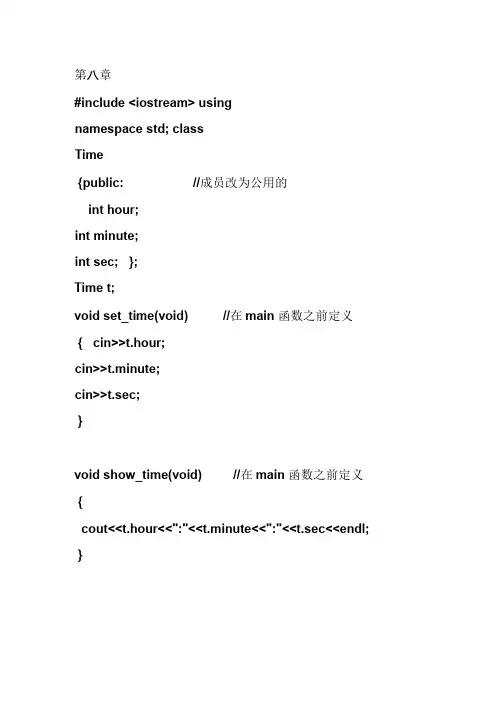
第八章#include <iostream> usingnamespace std; classTime{public: //成员改为公用的int hour;int minute;int sec; };Time t;void set_time(void) //在main 函数之前定义{ cin>>t.hour;cin>>t.minute;cin>>t.sec;}void show_time(void) //在main 函数之前定义 {cout<<t.hour<<":"<<t.minute<<":"<<t.sec<<endl; }int main(){set_time();show_time(); return0;}8.2 题#include <iostream> usingnamespace std; classTime{public:void set_time(void){cin>>hour;cin>>minute;cin>>sec; } voidshow_time(void){cout<<hour<<":"<<minute<<":"<<sec<<endl;} private: int hour;int minute;int sec;};Time t; intmain(){t.set_time();t.show_time(); return 0;}8.3 题#include <iostream> using namespace std; class Time{public:void set_time(void); void show_time(void); private: int hour; int minute;int sec;}; voidTime::set_time(void){cin>>hour;cin>>minute; cin>>sec;} voidTime::show_time(void){cout<<hour<<":"<<minute<<":"<<sec<<endl;}Time t; intmain(){ t.set_time();t.show_time(); return0;}8.4 题//xt8-4.h(student.h) class Student { public:void display( );v oid set_value();private: int num;char name[20];char sex ;};8.4 题//xt8-4-1.cpp(main.cpp)#include <iostream>using namespace std;#include "xt8-4.h" intmain() {Student stud;stud.set_value();stud.display(); return0;}8.4 题另一解//xt8-4-2.cpp(即student.cpp) #include "xt8-4.h" //在此文件中进行函数的定义#include <iostream> using namespace std;//不要漏写此行 void Student::display( ){ cout<<"num:"<<num<<endl; cout<<"name:"<<name<<endl; cout<<"sex:"<<sex<<endl;}void Student::set_value(){ cin>>num;cin>>name; cin>>sex;}8.5 题//xt8-5.h(arraymax.h)class Array_max {public:void set_value();void max_value(); voidshow_value(); private:int array[10]; int max;};8.5 题//xt8-5-1.cpp(file1.cpp)#include <iostream>#include "xt8-5.h" intmain(){Array_max arrmax; arrmax.set_value(); arrmax.max_value(); arrmax.show_value(); return 0;}8.5 题//xt8-5-2.cpp(arraymax.cpp) #include <iostream> using namespace std; #include "xt8-5.h"void Array_max::set_value() { int i;for (i=0;i<10;i++)cin>>array[i];}void Array_max::max_value(){int i;max=array[0]; for(i=1;i<10;i++) if(array[i]>max) max=array[i];}void Array_max::show_value() {cout<<"max="<<max<<endl; }8.6 题#include <iostream>using namespace std;class Box {public:void get_value();float volume(); voiddisplay(); public:float lengh;float width; floatheight;};void Box::get_value(){ cout<<"please input lengh, width,height:"; cin>>lengh; cin>>width; cin>>height;}float Box::volume(){ return(lengh*width*height);}void Box::display(){ cout<<volume()<<endl;}int main(){Box box1,box2,box3;box1.get_value();cout<<"volmue of bax1 is ";box1.display();box2.get_value();cout<<"volmue of bax2 is ";box2.display();box3.get_value();cout<<"volmue of bax3 is ";box3.display(); return 0;}8.6 题另一解#include <iostream> usingnamespace std; class Box{public:void get_value();void volume(); voiddisplay(); public:float lengh;float width; floatheight; float vol;};void Box::get_value(){ cout<<"please input lengh, width,height:"; cin>>lengh; cin>>width; cin>>height;}void Box::volume(){ vol=lengh*width*height;}void Box::display(){ cout<<vol<<endl;}int main(){Box box1,box2,box3;box1.get_value();box1.volume();cout<<"volmue of bax1 is "; box1.display();box2.get_value();box2.volume();cout<<"volmue of bax2 is "; box2.display();box3.get_value();box3.volume();cout<<"volmue of bax3 is "; box3.display(); return 0;}9.2 题#include <iostream> usingnamespace std; classDate{public:Date(int,int,int);Date(int,int);Date(int);Date(); voiddisplay();private: intmonth; int day;int year;};Date::Date(int m,int d,int y):month(m),day(d),year(y) { }Date::Date(int m,int d):month(m),day(d){year=2005;}Date::Date(int m):month(m){day=1;year=2005;}Date::Date(){month=1;day=1; year=2005;}void Date::display(){cout<<month<<"/"<<day<<"/"<<year<<endl;} intmain(){Date d1(10,13,2005);Date d2(12,30);Date d3(10); Dated4; d1.display();d2.display();d3.display();d4.display();return 0;}9.3 题#include <iostream>using namespace std; classDate{public:Date(int=1,int=1,int=2005);void display(); private: intmonth; int day; int year;};Date::Date(int m,int d,int y):month(m),day(d),year(y) { }void Date::display(){cout<<month<<"/"<<day<<"/"<<year<<endl;}intmain(){Date d1(10,13,2005);Date d2(12,30);Date d3(10);Date d4;d1.display();d2.display();d3.display();d4.display(); return0;}9.4 题#include <iostream> using namespace std; class Student{public:Student(int n,float s):num(n),score(s){}void display(); private: int num; floatscore;};void Student::display(){cout<<num<<" "<<score<<endl;}int main(){Student stud[5]={Student(101,78.5),Student(102,85.5),Student(103,98.5), Student(104,100.0),Student(105,95.5)};Student *p=stud; for(inti=0;i<=2;p=p+2,i++) p->display(); return0;}9.5 题#include <iostream> usingnamespace std; classStudent{public:Student(int n,float s):num(n),score(s){}int num; float score;};void main(){Student stud[5]={Student(101,78.5),Student(102,85.5),Student(103,98.5), Student(104,100.0),Student(105,95.5)}; voidmax(Student* ); Student *p=&stud[0]; max(p);}void max(Student *arr) {floatmax_score=arr[0].score; int k=0; for(inti=1;i<5;i++) if(arr[i].score>max_score){max_score=arr[i].score;k=i;}cout<<arr[k].num<<" "<<max_score<<endl;}9.6 题#include <iostream> usingnamespace std; classStudent{public:Student(int n,float s):num(n),score(s){} void change(int n,float s) {num=n;score=s;} void display(){cout<<num<<" "<<score<<endl;} private: int num; float score;};int main(){Student stud(101,78.5);stud.display();stud.change(101,80.5);stud.display(); return 0;}9.7 题#include <iostream>using namespace std; classStudent{public:Student(int n,float s):num(n),score(s){} void change(int n,float s) {num=n;score=s;} void display() {cout<<num<<" "<<score<<endl;}// 可改为:void display() const {cout<<num<<" "<<score<<endl;}private: intnum; floatscore;};int main(){const Student stud(101,78.5);stud.display();//stud.change(101,80.5);stud.display(); return 0;}9.7 题另一解#include <iostream> usingnamespace std; classStudent{public:Student(int n,float s):num(n),score(s){} void change(int n,float s) const {num=n;score=s;} void display() const {cout<<num<<" "<<score<<endl;} private:mutable int num;mutable float score;};int main(){const Student stud(101,78.5);stud.display();stud.change(101,80.5);stud.display(); return 0;#include <iostream> usingnamespace std;}9.7 题另一解Student(int n,float s):num(n),score(s){} void change(int n,float s) {num=n;score=s;} void display() {cout<<num<<" "<<score<<endl;} private: int num; float score;};int main(){Student stud(101,78.5);Student *p=&stud;p->display();p->change(101,80.5);p->display(); return 0;}9.7 题另一解#include <iostream> usingnamespace std;AStudent(int n,float s):num(n),score(s){} void change(int n,float s) {num=n;score=s;} void display() {cout<<num<<" "<<score<<endl;} private:mutable int num;mutable float score;};int main(){Student stud(101,78.5);const Student *p=&stud;p->display();p->change(101,80.5);p->display(); return 0;9.7 题另一解#include <iostream> usingnamespace std;}BStudent(int n,float s):num(n),score(s){} void change(int n,float s) {num=n;score=s;} void display() const{cout<<num<<" "<<score<<endl;} private: int num; float score;};int main(){Student stud(101,78.5);const Student *p=&stud;p->display();stud.change(101,80.5);p->display(); return 0;9.7 题另一解#include <iostream> usingnamespace std;}9.7 题另一解#include <iostream> using namespace std;Student(int n,float s):num(n),score(s){} void change(int n,float s) {num=n;score=s;} void display() {cout<<num<<" "<<score<<endl;} private: int num; float score;};int main(){Student stud(101,78.5);Student * const p=&stud;p->display();p->change(101,80.5);p->display(); return 0;}9.8 题Student(int n,float s):num(n),score(s){} void change(int n,float s) {num=n;score=s;} void display() {cout<<num<<" "<<score<<endl;} private: int num; float score;#include <iostream> using};int main(){Student stud(101,78.5);void fun(Student&);fun(stud); return 0;}void fun(Student &stu){stu.display(); stu.change(101,80.5);stu.display();}9.9 题#include <iostream> usingnamespace std; classProduct{public:Product(int n,int q,floatp):num(n),quantity(q),price(p){}; void total(); static floataverage(); static voiddisplay();private: int num;int quantity; floatprice; static floatdiscount; static floatsum; static int n;};void Product::total(){float rate=1.0; if(quantity>10) rate=0.98*rate; sum=sum+quantity*price*rate*(1-discount);n=n+quantity;}void Product::display(){cout<<sum<<endl;cout<<average()<<endl;}float Product::average(){return(sum/n);}float Product::discount=0.05;float Product::sum=0; intProduct::n=0;int main(){ProductProd[3]={ Product(101,5,23.5),Product(102,12,24.56),Produ ct(103,100,21.5) }; for(inti=0;i<3;i++)Prod[i].total();Product::display();return 0;}9.10 题#include <iostream>using namespace std;class Date; classTime{public:Time(int,int,int); friend void display(const Date&,const Time &); private: int hour; int minute;int sec;};Time::Time(int h,int m,int s){hour=h;minute=m; sec=s;}class Date{public:Date(int,int,int); friend void display(const Date &,const Time &); private: int month; int day; int year;};Date::Date(int m,int d,int y){month=m;day=d; year=y;}void display(const Date &d,const Time &t){cout<<d.month<<"/"<<d.day<<"/"<<d.year<<endl; cout<<t.hour<<":"<<t.minute<<":"<<t.sec<<endl; }intmain(){Time t1(10,13,56);Date d1(12,25,2004); display(d1,t1); return0;}9.11 题#include <iostream> using namespace std; class Time;class Date{public:Date(int,int,int);friend Time;private: intmonth; int day;int year;};Date::Date(int m,int d,int y):month(m),day(d),year(y){ }class Time{public:Time(int,int,int); voiddisplay(const Date &);private: int hour; intminute; int sec;};Time::Time(int h,int m,int s):hour(h),minute(m),sec(s){ }void Time::display(const Date &d){cout<<d.month<<"/"<<d.day<<"/"<<d.year<<endl; cout<<hour<<":"<<minute<<":"<<sec<<endl;}intmain(){Time t1(10,13,56);Date d1(12,25,2004);t1.display(d1); return0;}9.12 题#include <iostream>using namespace std;template<class numtype>class Compare{public:Compare(numtype a,numtype b);numtype max(); numtype min();private:numtype x,y;};template <class numtype>Compare<numtype>::Compare(numtype a,numtype b){x=a;y=b;} template <class numtype>numtype Compare<numtype>::max(){return (x>y)?x:y;} template <classnumtype> numtypeCompare<numtype>::min(){return (x<y)?x:y;}int main(){Compare<int> cmp1(3,7); cout<<cmp1.max()<<" is the Maximum of two integer numbers."<<endl;cout<<cmp1.min()<<" is the Minimum of two integer numbers."<<endl<<endl;Compare<float> cmp2(45.78,93.6); cout<<cmp2.max()<<" is the Maximum of two float numbers."<<endl;cout<<cmp2.min()<<" is the Minimum of two float numbers."<<endl<<endl; Compare<char> cmp3('a','A');is the Maximum of two cout<<cmp3.max()<<"characters."<<endl;cout<<cmp3.min()<<" is the Minimum of two characters."<<endl; return0;}10.1 题#include <iostream> usingnamespace std; classComplex{public:Complex(){real=0;imag=0;}Complex(double r,double i){real=r;imag=i;} double get_real();double get_imag(); voiddisplay(); private:double real;double imag;};double Complex::get_real(){return real;}double Complex::get_imag(){return imag;}void Complex::display(){cout<<"("<<real<<","<<imag<<"i)"<<endl;}Complex operator + (Complex &c1,Complex &c2){returnComplex(c1.get_real()+c2.get_real(),c1.get_imag()+c2.ge t_imag());}int main(){Complex c1(3,4),c2(5,-10),c3;c3=c1+c2; cout<<"c3=";c3.display(); return 0;}10.2 题#include <iostream> usingnamespace std; classComplex{public:Complex(){real=0;imag=0;}Complex(double r,double i){real=r;imag=i;} Complex operator+(Complex &c2);Complex operator-(Complex &c2);Complex operator*(Complex &c2); Complex operator/(Complex &c2); void display();private:double real;double imag;};Complex Complex::operator+(Complex &c2) {Complex c;c.real=real+c2.real;c.imag=imag+c2.imag; returnc;}Complex Complex::operator-(Complex &c2) {Complex c;c.real=real-c2.real;c.imag=imag-c2.imag; returnc;}Complex Complex::operator*(Complex &c2) {Complex c;c.real=real*c2.real-imag*c2.imag;c.imag=imag*c2.real+real*c2.imag; returnc;}Complex Complex::operator/(Complex &c2) {Complex c;c.real=(real*c2.real+imag*c2.imag)/(c2.real*c2.real+c2.i mag*c2.imag);c.imag=(imag*c2.real-real*c2.imag)/(c2.real*c2.real+c2.i mag*c2.imag); return c;}void Complex::display(){cout<<"("<<real<<","<<imag<<"i)"<<endl;}int main(){Complex c1(3,4),c2(5,-10),c3;c3=c1+c2; cout<<"c1+c2=";c3.display(); c3=c1-c2;cout<<"c1-c2="; c3.display();c3=c1*c2;cout<<"c1*c2=";c3.display();c3=c1/c2;cout<<"c1/c2=";c3.display(); return0;}10.3 题#include <iostream> //用VC++时改为∶ #include <iostream.h> using namespace std; //用VC++时为取消此行 class Complex{public:Complex(){real=0;imag=0;}Complex(double r,double i){real=r;imag=i;}Complex operator+(Complex &c2); Complex operator+(int &i); friend Complex operator+(int&,Complex &); void display(); private:double real;double imag;};Complex Complex::operator+(Complex &c) {return Complex(real+c.real,imag+c.imag);}Complex Complex::operator+(int &i){return Complex(real+i,imag);}void Complex::display(){cout<<"("<<real<<","<<imag<<"i)"<<endl;}Complex operator+(int &i,Complex &c) {return Complex(i+c.real,c.imag);}int main(){Complex c1(3,4),c2(5,-10),c3;int i=5;c3=c1+c2; cout<<"c1+c2=";c3.display(); c3=i+c1;cout<<"i+c1="; c3.display();c3=c1+i; cout<<"c1+i=";c3.display(); return 0;}10.4 题#include <iostream> using namespace std; class Matrix //定义Matrix 类{public:Matrix(); //默认构造函数friend Matrix operator+(Matrix &,Matrix &); //重载运算符“+”void input(); //输入数据函数void display(); // 输出数据函数private:int mat[2][3];};Matrix::Matrix() //定义构造函数{for(int i=0;i<2;i++)for(int j=0;j<3;j++)mat[i][j]=0;}Matrix operator+(Matrix &a,Matrix &b) //定义重载运算符“+” 函数{Matrix c; for(inti=0;i<2;i++) for(intj=0;j<3;j++){c.mat[i][j]=a.mat[i][j]+b.mat[i][j];} return c;}void Matrix::input() // 定义输入数据函数{cout<<"input value of matrix:"<<endl;for(int i=0;i<2;i++) for(int j=0;j<3;j++)cin>>mat[i][j];}void Matrix::display() //定义输出数据函数{for (int i=0;i<2;i++){for(int j=0;j<3;j++){cout<<mat[i][j]<<" ";} cout<<endl;}}int main() {Matrixa,b,c;a.input();b.input(); cout<<endl<<"Matrixa:"<<endl;a.display(); cout<<endl<<"Matrixb:"<<endl;b.display(); c=a+b; //用重载运算符“+”实现两个矩阵相加cout<<endl<<"Matrix c = Matrix a + Matrix b :"<<endl;c.display(); return0;}10.5 题#include <iostream.h> //using namespace std; class Matrix {public: Matrix(); friend Matrixoperator+(Matrix &,Matrix &); friend ostream& operator<<(ostream&,Matrix&); friend istream& operator>>(istream&,Matrix&); private:int mat[2][3];};Matrix::Matrix() {for(inti=0;i<2;i++) for(intj=0;j<3;j++)mat[i][j]=0;}Matrix operator+(Matrix &a,Matrix &b){Matrix c; for(inti=0;i<2;i++) for(intj=0;j<3;j++){c.mat[i][j]=a.mat[i][j]+b.mat[i][j];} returnc;}istream& operator>>(istream &in,Matrix &m) {cout<<"input value of matrix:"<<endl;for(int i=0;i<2;i++) for(int j=0;j<3;j++)in>>m.mat[i][j]; return in;}ostream& operator<<(ostream &out,Matrix &m) {for (int i=0;i<2;i++){for(int j=0;j<3;j++){out<<m.mat[i][j]<<" ";}out<<endl;} return out;}int main() { Matrix a,b,c; cin>>a; cin>>b;cout<<endl<<"Matrix a:"<<endl<<a<<endl;cout<<endl<<"Matrix b:"<<endl<<b<<endl;c=a+b;cout<<endl<<"Matrix c = Matrix a + Matrix b :"<<endl<<c<<endl;return 0;}10.6 题#include <iostream> usingnamespace std; classComplex{public:Complex(){real=0;imag=0;}Complex(double r){real=r;imag=0;}Complex(double r,double i){real=r;imag=i;}operator double(){return real;} voiddisplay(); private: double real; doubleimag;}; voidComplex::display(){cout<<"("<<real<<", "<<imag<<")"<<endl;}int main() {Complexc1(3,4),c2; double d1;d1=2.5+c1;cout<<"d1="<<d1<<endl;c2=Complex(d1);cout<<"c2=";c2.display(); return 0;}10.7 题#include <iostream> usingnamespace std; classStudent{public:Student(int,char[],char,float); intget_num(){return num;} char *get_name(){return name;} charget_sex(){return sex;} voiddisplay(){cout<<"num:"<<num<<"\nname:"<<name<<"\nsex:"<<se x<<"\nscore:"<<score<<"\n\n";}private: intnum; charname[20];char sex;float score;};Student::Student(int n,char nam[],char s,float so){num=n;strcpy(name,nam);sex=s; score=so;}class Teacher{public:Teacher(){}Teacher(Student&);Teacher(int n,char nam[],char sex,float pay); void display(); private: int num; charname[20]; char sex;float pay;};Teacher::Teacher(int n,char nam[],char s,float p) {num=n;strcpy(name,nam);sex=s; pay=p;}Teacher::Teacher(Student& stud){num=stud.get_num();strcpy(name,stud.get_name());sex=stud.get_sex(); pay=1500;}void Teacher::display()。
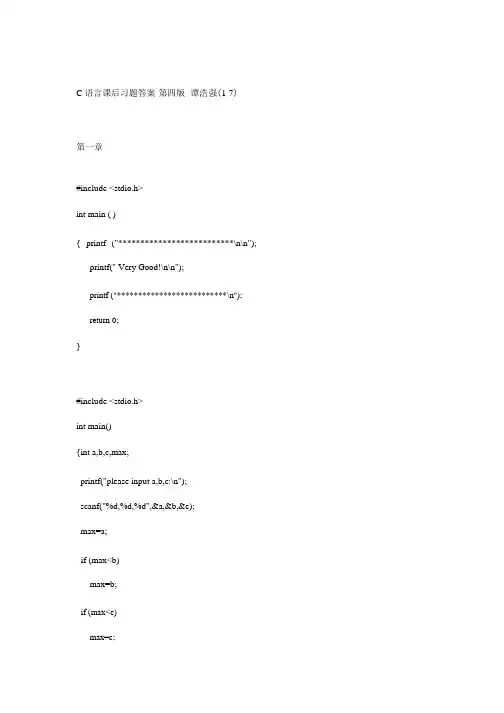
C 语言课后习题答案-第四版- 谭浩强(1-7)第一章#include <stdio.h>int main ( ){ printf ("**************************\n\n");printf(" Very Good!\n\n");printf ("**************************\n");return 0;}#include <stdio.h>int main(){int a,b,c,max;printf("please input a,b,c:\n");scanf("%d,%d,%d",&a,&b,&c);max=a;if (max<b)max=b;if (max<c)max=c;printf("The largest number is %d\n",max); return 0;}第3章#include <stdio.h>#include <math.h>int main(){float p,r,n;r=0.1;n=10;p=pow(1+r,n);printf("p=%f\n",p);return 0;}#include <stdio.h>#include <math.h>int main(){float r5,r3,r2,r1,r0,p,p1,p2,p3,p4,p5;p=1000;r5=0.0585;r3=0.054;r2=0.0468;r1=0.0414;r0=0.0072;p1=p*((1+r5)*5); // 一次存 5 年期p2=p*(1+2*r2)*(1+3*r3); // 先存 2 年期,到期后将本息再存 3 年期p3=p*(1+3*r3)*(1+2*r2); // 先存 3 年期,到期后将本息再存 2 年期p4=p*pow(1+r1,5); // 存 1 年期,到期后将本息存再存 1 年期,连续存 5 次p5=p*pow(1+r0/4,4*5); // 存活期存款。
《C语言程序设计》课后习题答案(第四版)谭浩强第1章程序设计和c语言11.1什么是计算机程序11.2什么是计算机语言11.3c语言的发展及其特点31.4最简单的c语言程序51.4.1最简单的c语言程序示例61.4.2c语言程序结构101.5运行c程序的步骤与方法121.6程序设计的任务141-5#includeintmain(){printf(\printf(\verygood!\\n\\n\printf(\return0;}1-6#includeintmain(){inta,b,c,max;printf(\scanf(\max=a;if(maxprintf(\return0;}第2章算法——程序的灵魂162.1算法是什么162.2简单算法示例172.3算法的特点212.4怎样表示一个算法222.4.1用自然语言表示算法222.4.2用流程图表示算法222.4.3三种基本结构和改进的流程图262.4.4用NS流程图表示算法282.4.5用伪码312表示算法。
4.6用计算机语言32表示算法2.5结构化程序设计方法34习题36第三章最简单的c语言编程-顺序编程373.1顺序编程的例子373.2数据的表现形式及其运算393.2.1常量和变量393.2.2数据类型423.2.3整型数据443.2.4字符型数据473.2.5浮点型数据493.2.6如何确定常数的类型513.2.7运算符和表达式523.3c语句573.3.1c语句的作用和分类573.3.2最基本的语句-赋值语句593.4数据输入和输出653.4.1输入和输出示例653.4.2有关数据输入输出的概念673.4.3用printf函数输出数据683.4.4用scanf函数输入数据753.4.5字符数据的输入输出78习题823-1#include#includeintmain(){floatp,r,n;r=0.1;n=10;p=pow(1+r,n);printf(\return0;}3-2-1#include#includeintmain(){r5,r3,r2,r1,r0,p,p1,p2,p3,p4,p5;p=1000;r5=0.0585;r3=0.054;r2=0.0468;r1=0.0414;r0=0.0072;p1=p*((1+r5)*5);//5年一次定期存款p2=p*(1+2*r2)*(1+3*r3);//先存2年期,到期后将本息再存3年期p3=p*(1+3*r3)*(1+2*r2);//先存3年期,到期后将本息再存2年期p4=p*pow(1+r1,5);//存1年,到期后再存1年本息,连续存5次P5=P*pow(1+R0/4,4*5)//存款存续期。
1-5 #include <>int main ( ){ printf ("**************************\n\n"); printf(" Very Good!\n\n");printf ("**************************\n"); return 0;}1-6#include <>int main(){int a,b,c,max;printf("please input a,b,c:\n");scanf("%d,%d,%d",&a,&b,&c);max=a;if (max<b)max=b;if (max<c)max=c;printf("The largest number is %d\n",max);return 0;}3-1 #include <>#include <>int main(){float p,r,n;r=;n=10;p=pow(1+r,n);printf("p=%f\n",p);return 0;}3-2-1#include <>#include <>int main(){float r5,r3,r2,r1,r0,p,p1,p2,p3,p4,p5;p=1000;r5=;r3=;r2=;r1=;r0=;p1=p*((1+r5)*5); #include <>#include <>int main(){float d=300000,p=6000,r=,m;m=log10(p/(p-d*r))/log10(1+r);printf("m=%\n",m);return 0;}3-4#include <>int main(){int c1,c2;c1=197;c2=198;printf("c1=%c,c2=%c\n",c1,c2);printf("c1=%d,c2=%d\n",c1,c2);return 0;}3-5#include <>int main(){int a,b;float x,y;char c1,c2;scanf("a=%d b=%d",&a,&b);scanf("%f %e",&x,&y);scanf("%c%c",&c1,&c2);printf("a=%d,b=%d,x=%f,y=%f,c1=%c,c2=%c\n",a,b,x,y,c1,c2); return 0;}3-6#include <>int main(){char c1='C',c2='h',c3='i',c4='n',c5='a';c1=c1+4;c2=c2+4;c3=c3+4;c4=c4+4;c5=c5+4;printf("passwor is %c%c%c%c%c\n",c1,c2,c3,c4,c5);return 0;}3-7#include <>int main (){float h,r,l,s,sq,vq,vz;float pi=;printf("请输入圆半径r,圆柱高h∶");scanf("%f,%f",&r,&h); #include <> int main(){ int x,y;printf("输入x:");scanf("%d",&x);if(x<1) /* x<1 */{ y=x;printf("x=%3d, y=x=%d\n" ,x,y);}else if(x<10) /* 1=<x<10 */{ y=2*x-1;printf("x=%d, y=2*x-1=%d\n",x,y);}else /* x>=10 */{ y=3*x-11;printf("x=%d, y=3*x-11=%d\n",x,y);}return 0;}4-8#include <>int main(){ float score;char grade;printf("请输入学生成绩:");scanf("%f",&score);while (score>100||score<0){printf("\n 输入有误,请重输");scanf("%f",&score);}switch((int)(score/10)){case 10:case 9: grade='A';break;case 8: grade='B';break;case 7: grade='C';break;case 6: grade='D';break;case 5:case 4:case 3:case 2:case 1:case 0: grade='E';}printf("成绩是 %,相应的等级是%c\n ",score,grade);return 0;}4-10-1#include <>int main(){int i;double bonus,bon1,bon2,bon4,bon6,bon10;bon1=100000*;bon2=bon1+100000*;bon4=bon2+100000*;bon6=bon4+100000*;bon10=bon6+400000*;printf("请输入利润i:");scanf("%d",&i);if (i<=100000)bonus=i*;else if (i<=200000)bonus=bon1+(i-100000)*;else if (i<=400000)bonus=bon2+(i-200000)*;else if (i<=600000)bonus=bon4+(i-400000)*;else if (i<=1000000)bonus=bon6+(i-600000)*;elsebonus=bon10+(i-1000000)*;printf("奖金是: %\n",bonus);return 0;}4-10-2#include <>int main(){int i;double bonus,bon1,bon2,bon4,bon6,bon10;int branch;bon1=100000*;bon2=bon1+100000*;bon4=bon2+200000*;bon6=bon4+200000*;bon10=bon6+400000*;printf("请输入利润i:");scanf("%d",&i);branch=i/100000;if (branch>10) branch=10;switch(branch){ case 0:bonus=i*;break;case 1:bonus=bon1+(i-100000)*;break; case 2:case 3: bonus=bon2+(i-200000)*;break; case 4:case 5: bonus=bon4+(i-400000)*;break; case 6:case 7:case 8:case 9: bonus=bon6+(i-600000)*;break; case 10: bonus=bon10+(i-1000000)*;}printf("奖金是 %\n",bonus);return 0;}4-11#include <>int main(){int t,a,b,c,d;printf("请输入四个数:");scanf("%d,%d,%d,%d",&a,&b,&c,&d);printf("a=%d,b=%d,c=%d,d=%d\n",a,b,c,d); if (a>b){ t=a;a=b;b=t;}if (a>c){ t=a;a=c;c=t;}if (a>d){ t=a;a=d;d=t;}if (b>c){ t=b;b=c;c=t;}if (b>d){ t=b;b=d;d=t;}if (c>d){ t=c;c=d;d=t;}printf("排序结果如下: \n");printf("%d %d %d %d \n" ,a,b,c,d); return 0;}4-12#include <>int main(){int h=10;float x1=2,y1=2,x2=-2,y2=2,x3=-2,y3=-2,x4=2,y4=-2,x,y,d1,d2,d3,d4; printf("请输入一个点(x,y):");scanf("%f,%f",&x,&y);d1=(x-x4)*(x-x4)+(y-y4)*(y-y4); /*求该点到各中心点距离*/ d2=(x-x1)*(x-x1)+(y-y1)*(y-y1);d3=(x-x2)*(x-x2)+(y-y2)*(y-y2);d4=(x-x3)*(x-x3)+(y-y3)*(y-y3);if (d1>1 && d2>1 && d3>1 && d4>1) h=0; /*判断该点是否在塔外*/ printf("该点高度为 %d\n",h);return 0;}5-3#include <>int main(){int p,r,n,m,temp;printf("请输入两个正整数n,m:");scanf("%d,%d,",&n,&m);if (n<m){temp=n;n=m;m=temp;}p=n*m;while(m!=0){r=n%m;n=m;m=r;}printf("它们的最大公约数为:%d\n",n);printf("它们的最小公约数为:%d\n",p/n);return 0;}5-4#include <>int main(){char c;int letters=0,space=0,digit=0,other=0;printf("请输入一行字符:\n");while((c=getchar())!='\n'){if (c>='a' && c<='z' || c>='A' && c<='Z')letters++;else if (c==' ')space++;else if (c>='0' && c<='9')digit++;elseother++;}printf("字母数:%d\n空格数:%d\n数字数:%d\n其它字符数:%d\n",letters,space,digit,other);return 0;}5-5#include <>int main(){int a,n,i=1,sn=0,tn=0;printf("a,n=:");scanf("%d,%d",&a,&n);while (i<=n){tn=tn+a; /*赋值后的tn为i个 a组成数的值*/sn=sn+tn; /*赋值后的sn为多项式前i项之和*/a=a*10;++i;}printf("a+aa+aaa+...=%d\n",sn);return 0;}5-6#include <>int main(){double s=0,t=1;int n;for (n=1;n<=20;n++){t=t*n;s=s+t;}printf("1!+2!+...+20!=%\n",s);return 0;}5-7#include <>int main(){int n1=100,n2=50,n3=10;double k,s1=0,s2=0,s3=0;for (k=1;k<=n1;k++) /*计算1到100的和*/{s1=s1+k;}for (k=1;k<=n2;k++) /*计算1到50各数的平方和*/ {s2=s2+k*k;}for (k=1;k<=n3;k++) /*计算1到10的各倒数和*/ {s3=s3+1/k;}printf("sum=%\n",s1+s2+s3);return 0;}5-8#include <>int main(){int i,j,k,n;printf("parcissus numbers are ");for (n=100;n<1000;n++){i=n/100;j=n/10-i*10;k=n%10;if (n==i*i*i + j*j*j + k*k*k)printf("%d ",n);}printf("\n");return 0;}5-9#include <>int main(){int m,s,i;for (m=2;m<1000;m++){s=0;for (i=1;i<m;i++)if ((m%i)==0) s=s+i;if(s==m){printf("%d,its factors are ",m);for (i=1;i<m;i++)if (m%i==0) printf("%d ",i);printf("\n");}}return 0;}5-10#include <>int main(){int i,n=20;double a=2,b=1,s=0,t;for (i=1;i<=n;i++){s=s+a/b;t=a,a=a+b,b=t;}printf("sum=%\n",s);return 0;}5-11#include <>int main(){double sn=100,hn=sn/2;int n;for (n=2;n<=10;n++){sn=sn+2*hn; /*第n次落地时共经过的米数*/ hn=hn/2; /*第n次反跳高度*/}printf("第10次落地时共经过%f米\n",sn);printf("第10次反弹%f米\n",hn);return 0;}5-12#include <>int main(){int day,x1,x2;day=9;x2=1;while(day>0){x1=(x2+1)*2; /*第1天的桃子数是第2天桃子数加1后的2倍.*/ x2=x1;day--;}printf("total=%d\n",x1);return 0;}5-13#include <>#include <>int main(){float a,x0,x1;printf("enter a positive number:");scanf("%f",&a);x0=a/2;x1=(x0+a/x0)/2;do{x0=x1;x1=(x0+a/x0)/2;}while(fabs(x0-x1)>=1e-5);printf("The square root of % is %\n",a,x1);return 0;}5-14#include <>#include <>int main(){double x1,x0,f,f1;x1=;do{x0=x1;f=((2*x0-4)*x0+3)*x0-6;f1=(6*x0-8)*x0+3;x1=x0-f/f1;}while(fabs(x1-x0)>=1e-5);printf("The root of equation is %\n",x1);return 0;}5-15#include <>#include <>int main(){float x0,x1,x2,fx0,fx1,fx2; do{printf("enter x1 & x2:"); scanf("%f,%f",&x1,&x2); fx1=x1*((2*x1-4)*x1+3)-6; fx2=x2*((2*x2-4)*x2+3)-6; }while(fx1*fx2>0);do{x0=(x1+x2)/2;fx0=x0*((2*x0-4)*x0+3)-6; if ((fx0*fx1)<0){x2=x0;fx2=fx0;}else{x1=x0;fx1=fx0;}}while(fabs (fx0)>=1e-5); printf("x=%\n",x0);return 0;}5-16#include <>int main(){int i,j,k;for (i=0;i<=3;i++){for (j=0;j<=2-i;j++)printf(" ");for (k=0;k<=2*i;k++)printf("*");printf("\n");}for (i=0;i<=2;i++){for (j=0;j<=i;j++)printf(" ");for (k=0;k<=4-2*i;k++)printf("*");printf("\n");}return 0;}5-17#include <>int main(){char i,j,k; /*是a的对手;j是b的对手;k是c的对手*/ for (i='x';i<='z';i++)for (j='x';j<='z';j++)if (i!=j)for (k='x';k<='z';k++)if (i!=k && j!=k)if (i!='x' && k!='x' && k!='z')printf("A--%c\nB--%c\nC--%c\n",i,j,k);return 0;}6-1#include <>#include <>int main(){int i,j,n,a[101];for (i=1;i<=100;i++)a[i]=i;a[1]=0;for (i=2;i<sqrt(100);i++)for (j=i+1;j<=100;j++){if(a[i]!=0 && a[j]!=0)if (a[j]%a[i]==0)a[j]=0;}printf("\n");for (i=2,n=0;i<=100;i++){ if(a[i]!=0){printf("%5d",a[i]);n++;}if(n==10){printf("\n");n=0;}}printf("\n");return 0;}6-2#include <>int main(){int i,j,min,temp,a[11];printf("enter data:\n");for (i=1;i<=10;i++){printf("a[%d]=",i);scanf("%d",&a[i]);}printf("\n");printf("The orginal numbers:\n"); for (i=1;i<=10;i++)printf("%5d",a[i]);printf("\n");for (i=1;i<=9;i++){min=i;for (j=i+1;j<=10;j++)if (a[min]>a[j]) min=j;temp=a[i];a[i]=a[min];a[min]=temp;}printf("\nThe sorted numbers:\n"); for (i=1;i<=10;i++)printf("%5d",a[i]);printf("\n");return 0;}6-3#include <>int main(){int a[3][3],sum=0;int i,j;printf("enter data:\n");for (i=0;i<3;i++)for (j=0;j<3;j++)scanf("%3d",&a[i][j]);for (i=0;i<3;i++)sum=sum+a[i][i];printf("sum=%6d\n",sum);return 0;}6-4#include <>int main(){ int a[11]={1,4,6,9,13,16,19,28,40,100};int temp1,temp2,number,end,i,j;printf("array a:\n");for (i=0;i<10;i++)printf("%5d",a[i]);printf("\n");printf("insert data:");scanf("%d",&number);end=a[9];if (number>end)a[10]=number;else{for (i=0;i<10;i++){if (a[i]>number){temp1=a[i];a[i]=number;for (j=i+1;j<11;j++){temp2=a[j];a[j]=temp1;temp1=temp2;}break;}}}printf("Now array a:\n");for (i=0;i<11;i++)printf("%5d",a[i]);printf("\n");return 0;}6-5#include <>#define N 5int main(){ int a[N],i,temp;printf("enter array a:\n");for (i=0;i<N;i++)scanf("%d",&a[i]);printf("array a:\n");for (i=0;i<N;i++)printf("%4d",a[i]);for (i=0;i<N/2;i++) n",number);;printf("continu or not(Y/N)");scanf(" %c",&c);if (c=='N'||c=='n')flag=0;}return 0;}6-10#include <>int main(){int i,j,upp,low,dig,spa,oth;char text[3][80];upp=low=dig=spa=oth=0;for (i=0;i<3;i++){ printf("please input line %d:\n",i+1);gets(text[i]);for (j=0;j<80 && text[i][j]!='\0';j++){if (text[i][j]>='A'&& text[i][j]<='Z') upp++;else if (text[i][j]>='a' && text[i][j]<='z') low++;else if (text[i][j]>='0' && text[i][j]<='9') dig++;else if (text[i][j]==' ')spa++;elseoth++;}}printf("\nupper case: %d\n",upp);printf("lower case: %d\n",low);printf("digit : %d\n",dig);printf("space : %d\n",spa);printf("other : %d\n",oth);return 0;}6-11#include <>int main(){ char a[5]={'*','*','*','*','*'};int i,j,k;char space=' ';for (i=0;i<5;i++){ printf("\n");printf(" ");for (j=1;j<=i;j++)printf("%c",space);for (k=0;k<5;k++)printf("%c",a[k]);}printf("\n");return 0;}6-12a-c#include <>int main(){ int j,n;char ch[80],tran[80];printf("input cipher code:");gets(ch);printf("\ncipher code :%s",ch);j=0;while (ch[j]!='\0'){ if ((ch[j]>='A') && (ch[j]<='Z'))tran[j]=155-ch[j];else if ((ch[j]>='a') && (ch[j]<='z')) tran[j]=219-ch[j];elsetran[j]=ch[j];j++;}n=j;printf("\noriginal text:");for (j=0;j<n;j++)putchar(tran[j]);printf("\n");return 0;}6-12b#include <>int main(){int j,n;char ch[80];printf("input cipher code:\n");gets(ch);printf("\ncipher code:%s\n",ch);j=0;while (ch[j]!='\0'){ if ((ch[j]>='A') && (ch[j]<='Z'))ch[j]=155-ch[j];else if ((ch[j]>='a') && (ch[j]<='z'))ch[j]=219-ch[j];elsech[j]=ch[j];j++;}n=j;printf("original text:");for (j=0;j<n;j++)putchar(ch[j]);printf("\n");return 0;}6-13#include <>int main(){ char s1[80],s2[40];int i=0,j=0;printf("input string1:");scanf("%s",s1);printf("input string2:");scanf("%s",s2);while (s1[i]!='\0')i++;while(s2[j]!='\0')s1[i++]=s2[j++];s1[i]='\0';printf("\nThe new string is:%s\n",s1);return 0;}6-14#include <>int main(){ int i,resu;char s1[100],s2[100];printf("input string1:");gets(s1);printf("\ninput string2:");gets(s2);i=0;while ((s1[i]==s2[i]) && (s1[i]!='\0'))i++; if (s1[i]=='\0' && s2[i]=='\0')resu=0;elseresu=s1[i]-s2[i];printf("\nresult:%d.\n",resu); return 0;}6-15#include <>#include <>int main(){ char s1[80],s2[80];int i;printf("input s2:");scanf("%s",s2);for (i=0;i<=strlen(s2);i++)s1[i]=s2[i];printf("s1:%s\n",s1);return 0;}7-1-1#include <>int main(){int hcf(int,int);int lcd(int,int,int);int u,v,h,l;scanf("%d,%d",&u,&v);h=hcf(u,v);printf("",h);l=lcd(u,v,h);printf("",l);return 0;}int hcf(int u,int v){int t,r;if (v>u){t=u;u=v;v=t;}while ((r=u%v)!=0){u=v;v=r;}return(v);}int lcd(int u,int v,int h){return(u*v/h);}7-1-2#include <>int Hcf,Lcd;int main(){void hcf(int,int);void lcd(int,int);int u,v;scanf("%d,%d",&u,&v);hcf(u,v);lcd(u,v);printf("",Hcf);printf("",Lcd);return 0;}void hcf(int u,int v){int t,r;if (v>u){t=u;u=v;v=t;}while ((r=u%v)!=0){u=v;v=r;}Hcf=v;}void lcd(int u,int v){Lcd=u*v/Hcf;}7-2#include <>#include <>float x1,x2,disc,p,q;int main(){void greater_than_zero(float,float);void equal_to_zero(float,float);void smaller_than_zero(float,float);float a,b,c;printf("input a,b,c:");scanf("%f,%f,%f",&a,&b,&c);printf("equation: %*x*x+%*x+%=0\n",a,b,c);disc=b*b-4*a*c;printf("root:\n");if (disc>0){greater_than_zero(a,b);printf("x1=%f\t\tx2=%f\n",x1,x2);}else if (disc==0){equal_to_zero(a,b);printf("x1=%f\t\tx2=%f\n",x1,x2);}else{smaller_than_zero(a,b);printf("x1=%f+%fi\tx2=%f-%fi\n",p,q,p,q); }return 0;}void greater_than_zero(float a,float b){x1=(-b+sqrt(disc))/(2*a);x2=(-b-sqrt(disc))/(2*a);}void equal_to_zero(float a,float b){x1=x2=(-b)/(2*a);}void smaller_than_zero(float a,float b){p=-b/(2*a);q=sqrt(-disc)/(2*a);}7-3#include <>int main(){int prime(int);int n;printf("input an integer:");scanf("%d",&n);if (prime(n))printf("%d is a prime.\n",n);elseprintf("%d is not a prime.\n",n);return 0;}int prime(int n){int flag=1,i;for (i=2;i<n/2 && flag==1;i++) if (n%i==0)flag=0;return(flag);}7-4#include <>#define N 3int array[N][N];int main(){ void convert(int array[][3]); int i,j;printf("input array:\n");for (i=0;i<N;i++)for (j=0;j<N;j++)scanf("%d",&array[i][j]);printf("\noriginal array :\n"); for (i=0;i<N;i++){for (j=0;j<N;j++)printf("%5d",array[i][j]);printf("\n");}convert(array);printf("convert array:\n");for (i=0;i<N;i++){for (j=0;j<N;j++)printf("%5d",array[i][j]); printf("\n");}return 0;}void convert(int array[][3]){int i,j,t;for (i=0;i<N;i++)for (j=i+1;j<N;j++){t=array[i][j];array[i][j]=array[j][i];array[j][i]=t;}}#include <>#include <>int main(){void inverse(char str[]);char str[100];printf("input string:");scanf("%s",str);inverse(str);printf("inverse string:%s\n",str);return 0;}void inverse(char str[]){char t;int i,j;for (i=0,j=strlen(str);i<(strlen(str)/2);i++,j--){t=str[i];str[i]=str[j-1];str[j-1]=t;}}7-6#include <>int main(){void concatenate(char string1[],char string2[],char string[]); char s1[100],s2[100],s[100];printf("input string1:");scanf("%s",s1);printf("input string2:");scanf("%s",s2);concatenate(s1,s2,s);printf("\nThe new string is %s\n",s);return 0;}void concatenate(char string1[],char string2[],char string[]) {int i,j;for (i=0;string1[i]!='\0';i++)string[i]=string1[i];for(j=0;string2[j]!='\0';j++)string[i+j]=string2[j];string[i+j]='\0';}7-7#include <>int main(){void cpy(char [],char []);char str[80],c[80];printf("input string:");gets(str);cpy(str,c);printf("The vowel letters are:%s\n",c);return 0;}void cpy(char s[],char c[]){ int i,j;for (i=0,j=0;s[i]!='\0';i++)if (s[i]=='a'||s[i]=='A'||s[i]=='e'||s[i]=='E'||s[i]=='i'|| s[i]=='I'||s[i]=='o'||s[i]=='O'||s[i]=='u'||s[i]=='U'){c[j]=s[i];j++;}c[j]='\0';}7-8#include <>#include <>int main(){char str[80];void insert(char []);printf("input four digits:");scanf("%s",str);insert(str);return 0;}void insert(char str[]){int i;for (i=strlen(str);i>0;i--){str[2*i]=str[i];str[2*i-1]=' ';}printf("output:\n%s\n",str);}7-9#include <>int letter,digit,space,others;int main(){void count(char []);char text[80];printf("input string:\n");gets(text);printf("string:");puts(text);letter=0;digit=0;space=0;others=0;count(text);printf("\nletter:%d\ndigit:%d\nspace:%d\nothers:%d\n",letter,digit,space,others );return 0;}void count(char str[]){int i;for (i=0;str[i]!='\0';i++)if ((str[i]>='a'&& str[i]<='z')||(str[i]>='A' && str[i]<='Z'))letter++;else if (str[i]>='0' && str [i]<='9')digit++;else if (str[i]==32)space++;elseothers++;}7-10#include <>#include <>int main(){int alphabetic(char);int longest(char []);int i;char line[100];printf("input one line:\n");gets(line);printf("The longest word is :");for (i=longest(line);alphabetic(line[i]);i++) printf("%c",line[i]);printf("\n");return 0;}int alphabetic(char c){if ((c>='a' && c<='z')||(c>='A'&&c<='z'))return(1);elsereturn(0);}int longest(char string[]){int len=0,i,length=0,flag=1,place=0,point;for (i=0;i<=strlen(string);i++)if (alphabetic(string[i]))if (flag){point=i;flag=0;}elselen++;else{flag=1;if (len>=length){length=len;place=point;len=0;}}return(place);}7-11#include <>#include <>#define N 10char str[N];int main(){void sort(char []);int i,flag;for (flag=1;flag==1;){printf("input string:\n");scanf("%s",&str);if (strlen(str)>N)printf("string too long,input again!"); elseflag=0;}sort(str);printf("string sorted:\n");for (i=0;i<N;i++)printf("%c",str[i]);printf("\n");return 0;}void sort(char str[]){int i,j;char t;for(j=1;j<N;j++)for (i=0;(i<N-j)&&(str[i]!='\0');i++)if(str[i]>str[i+1]){t=str[i];str[i]=str[i+1];str[i+1]=t;}}7-12#include <>#include <>int main(){float solut(float a,float b,float c,float d); float a,b,c,d;printf("input a,b,c,d:");scanf("%f,%f,%f,%f",&a,&b,&c,&d);printf("x=%\n",solut(a,b,c,d));return 0;}float solut(float a,float b,float c,float d) {float x=1,x0,f,f1;do{x0=x;f=((a*x0+b)*x0+c)*x0+d;f1=(3*a*x0+2*b)*x0+c;x=x0-f/f1;}while(fabs(x-x0)>=1e-3);return(x);}7-16#include <>#define MAX 1000int main(){ int htoi(char s[]);int c,i,flag,flag1;char t[MAX];i=0;flag=0;flag1=1;printf("input a HEX number:");while((c=getchar())!='\0' && i<MAX&& flag1){if (c>='0' && c<='9'||c>='a' && c<='f'||c>='A' && c<='F') {flag=1;t[i++]=c;}else if (flag){t[i]='\0';printf("decimal number %d\n",htoi(t));printf("continue or not");c=getchar();if (c=='N'||c=='n')flag1=0;else{flag=0;i=0;printf("\ninput a HEX number:");}}}return 0;}int htoi(char s[]){ int i,n;n=0;for (i=0;s[i]!='\0';i++){if (s[i]>='0'&& s[i]<='9')n=n*16+s[i]-'0';if (s[i]>='a' && s[i]<='f')n=n*16+s[i]-'a'+10;if (s[i]>='A' && s[i]<='F')n=n*16+s[i]-'A'+10;}return(n);}7-17#include <>int main(){ void convert(int n);int number;printf("input an integer: ");scanf("%d",&number);printf("output: ");if (number<0){putchar('-');putchar(' '); /* 先输出一个‘-’号和空格 */ number=-number;}convert(number);printf("\n");return 0;}void convert(int n){ int i;if ((i=n/10)!=0)convert(i);putchar(n%10+'0');putchar(32);}7-18#include <>int main(){int sum_day(int month,int day);int leap(int year);int year,month,day,days;printf("input date(year,month,day):");scanf("%d,%d,%d",&year,&month,&day);printf("%d/%d/%d ",year,month,day);days=sum_day(month,day); /* 调用函数sum_day */ if(leap(year)&&month>=3) /* 调用函数leap */days=days+1;printf("is the %dth day in this year.\n",days);return 0;}int sum_day(int month,int day) /* 函数sum_day:计算日期 */ {int day_tab[13]={0,31,28,31,30,31,30,31,31,30,31,30,31};int i;for (i=1;i<month;i++)day+=day_tab[i]; /* 累加所在月之前天数 */return(day);} /* 函数leap:判断是否为闰年 */int leap(int year){int leap;leap=year%4==0&&year%100!=0||year%400==0;return(leap);}8-1#include <>int main(){ void swap(int *p1,int *p2);int n1,n2,n3;int *p1,*p2,*p3;printf("input three integer n1,n2,n3:");scanf("%d,%d,%d",&n1,&n2,&n3);p1=&n1;p2=&n2;p3=&n3;if(n1>n2) swap(p1,p2);if(n1>n3) swap(p1,p3);if(n2>n3) swap(p2,p3);printf("Now,the order is:%d,%d,%d\n",n1,n2,n3);return 0;}void swap(int *p1,int *p2){int p;p=*p1; *p1=*p2; *p2=p;}8-2#include <>#include <>int main(){void swap(char *,char *);char str1[20],str2[20],str3[20];printf("input three line:\n");gets(str1);gets(str2);gets(str3);if(strcmp(str1,str2)>0) swap(str1,str2); if(strcmp(str1,str3)>0) swap(str1,str3); if(strcmp(str2,str3)>0) swap(str2,str3); printf("Now,the order is:\n");printf("%s\n%s\n%s\n",str1,str2,str3);return 0;}void swap(char *p1,char *p2){char p[20];strcpy(p,p1);strcpy(p1,p2);strcpy(p2,p); }8-3#include <>int main(){ void input(int *);void max_min_value(int *);void output(int *);int number[10];input(number); max_min_value(number); output(number);return 0;}void input(int *number){int i;printf("input 10 numbers:");for (i=0;i<10;i++)scanf("%d",&number[i]);}void max_min_value(int *number) { int *max,*min,*p,temp;max=min=number;for (p=number+1;p<number+10;p++)if (*p>*max) max=p;else if (*p<*min) min=p;。
第1章程序设计和C语言11.1什么是计算机程序11.2什么是计算机语言11.3C语言的发展及其特点31.4最简单的C语言程序51.4.1最简单的C语言程序举例61.4.2C语言程序的结构101.5运行C程序的步骤与方法121.6程序设计的任务141-5 #include <stdio.h>int main ( ){ printf ("**************************\n\n");printf(" Very Good!\n\n");printf ("**************************\n");return 0;}1-6#include <stdio.h>int main(){int a,b,c,max;printf("please input a,b,c:\n");scanf("%d,%d,%d",&a,&b,&c);max=a;if (max<b)max=b;if (max<c)max=c;printf("The largest number is %d\n",max); return 0;}第2章算法——程序的灵魂162.1什么是算法162.2简单的算法举例172.3算法的特性212.4怎样表示一个算法222.4.1用自然语言表示算法222.4.2用流程图表示算法222.4.3三种基本结构和改进的流程图262.4.4用N S流程图表示算法282.4.5用伪代码表示算法312.4.6用计算机语言表示算法322.5结构化程序设计方法34习题36第章最简单的C程序设计——顺序程序设计37 3.1顺序程序设计举例373.2数据的表现形式及其运算393.2.1常量和变量393.2.2数据类型42.3.2.3整型数据443.2.4字符型数据473.2.5浮点型数据493.2.6怎样确定常量的类型513.2.7运算符和表达式523.3C语句573.3.1C语句的作用和分类573.3.2最基本的语句——赋值语句593.4数据的输入输出653.4.1输入输出举例653.4.2有关数据输入输出的概念673.4.3用printf函数输出数据683.4.4用scanf函数输入数据753.4.5字符数据的输入输出78习题823-1 #include <stdio.h>#include <math.h>int main(){float p,r,n;r=0.1;n=10;p=pow(1+r,n);printf("p=%f\n",p);return 0;}3-2-1#include <stdio.h>#include <math.h>int main(){float r5,r3,r2,r1,r0,p,p1,p2,p3,p4,p5;p=1000;r5=0.0585;r3=0.054;r2=0.0468;r1=0.0414;r0=0.0072;p1=p*((1+r5)*5); // 一次存5年期p2=p*(1+2*r2)*(1+3*r3); // 先存2年期,到期后将本息再存3年期p3=p*(1+3*r3)*(1+2*r2); // 先存3年期,到期后将本息再存2年期p4=p*pow(1+r1,5); // 存1年期,到期后将本息存再存1年期,连续存5次p5=p*pow(1+r0/4,4*5); // 存活期存款。
第一章 5:输出结果为: ThisisaC++program 6: 输出结果为: a+b=33 7: 求最小值 #include using namespace std; int main() { int a,b,c; int f(int x,int y,int z); cin>>a>>b>>c; c=f(a,b,c); cout< using namespace std; int main() { int a,b,c; cin>>a>>b; c=a+b; cout<<"a+b="< using namespace std; int main() {int add(int x,int y); int a,b,c; cin>>a>>b; c=add(a,b); cout<<"a+b="
void sort(int x, int y, int z) { int temp; if (x>y) {temp=x;x=y;y=temp;} //{ }内3个语句的作用是将x和y的值互换) if (zelse if (zcout
cout<<"max(a,b,c)=" int max(int a,int b,int c) {if(b>a) a=b; if(c>a) a=c; return a; } 12: #include using namespace std; int main() { void change(int ,int ); int a,b; cin>>a>>b; if(a>a>>b>>c; a1=a;b1=b;c1=c; sort(a1,b1,c1); cout 15: #include #include using namespace std; int main() { string str; int i,n; char temp; cout<<"please input a string:"; cin>>str; n=str.size(); for(i=0;i{temp=str[i];str[i]=str[n-i-1];str[n-i-1]=temp;} cout 16: #include #include using namespace std; int main() { int i; string str[5]={"BASIC","C","FORTRAN","C++","PASCAL"}; void sort(string []); sort(str); cout<<"the sorted strings :" void sort(float a[]) {int i,j; float t; for (j=0;j<5;j++) for(i=0;i<5-j;i++) if (a[i]>a[i+1]) {t=a[i];a[i]=a[i+1];a[i+1]=t;} cout<<"the sorted numbers :" 18: #include #include using namespace std; template void sort(T a[]) {int i,j,min; T t; for(i=0;i<5;i++) {min=i; for (j=i+1;j<5;j++) if(a[min]>a[j]) min=j; t=a[i]; a[i]=a[min]; a[min]=t; } cout<<"the sorted numbers :" int main() { int a[5]={1,9,0,23,-45}; float b[5]={2.4, 7.6, 5.5, 6.6, -2.3 }; long c[5]={10100,-123567, 1198783,-165654, 3456}; sort(a); sort(b); sort(c); return 0; } 第二章